
SUMMER 2023
SUMMER 2023, V7/3
Forests & Gardens is the member magazine for Holden Forests & Gardens, which includes the Holden Arboretum in Kirtland and the Cleveland Botanical Garden in Cleveland.
MISSION: Holden Forests & Gardens connects people with the wonder, beauty, and value of trees and plants, to inspire action for healthy communities
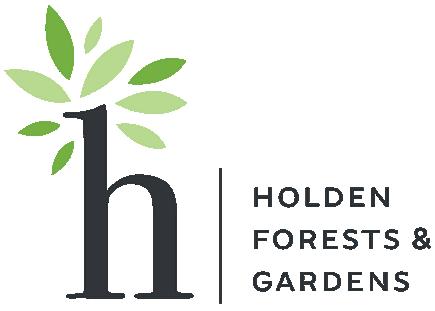
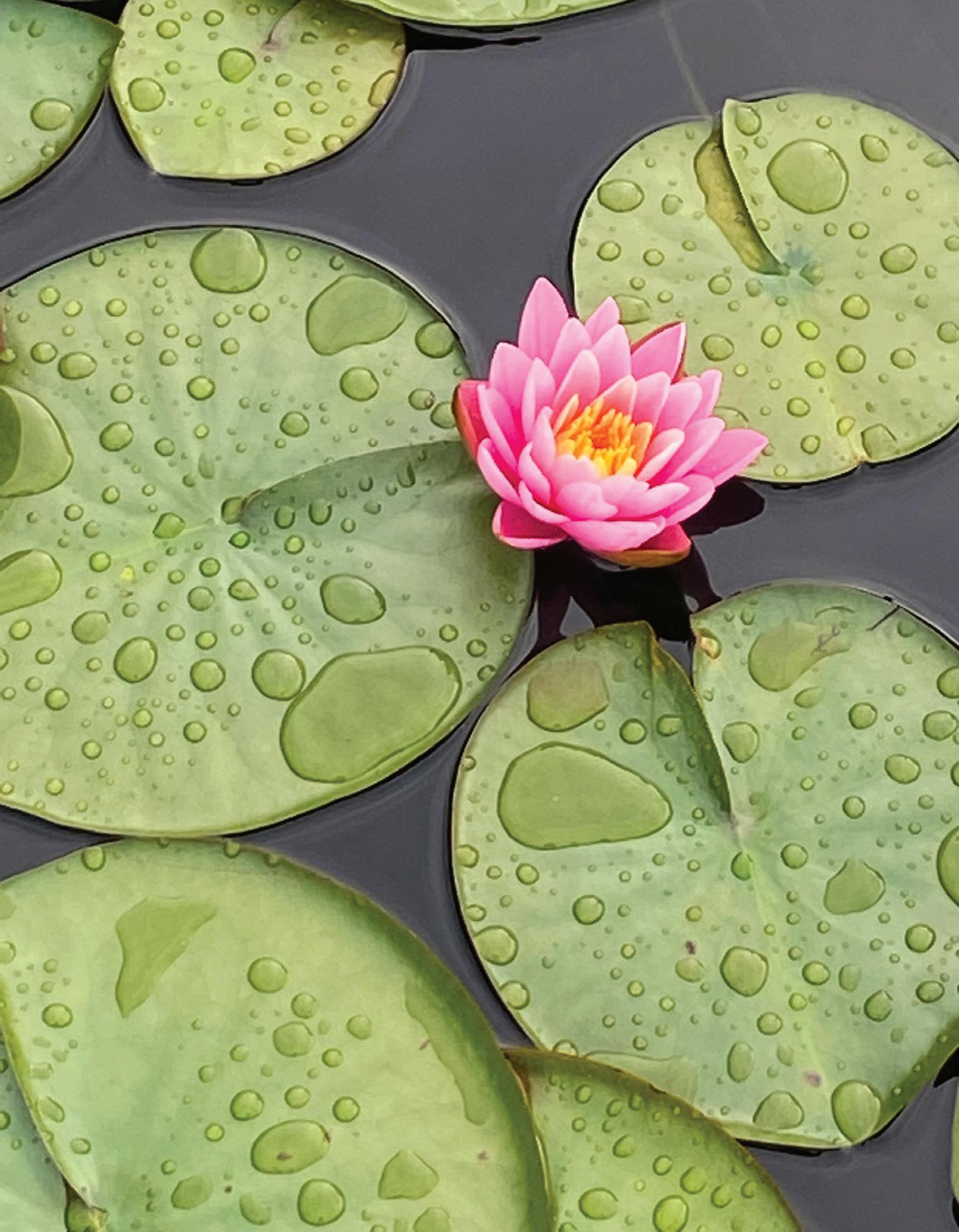
VISION: All communities transformed into vibrant places where trees, plants, and people thrive
Creative Director: Jackie Klisuric
Editor & Vice President of Public Relations & Marketing:

Margaret Thresher
Photography: Margaret Cook, Peter Greene, Ryan Harris, Ethan Johnson, Rachel Kappler, Jackie Klisuric, Hannah Morris, Ferole Parmelee, Bob Perkoski, Eric Seitz, Margaret Thresher, Nico Viola
BOARD OF DIRECTORS
Tom Anderson, Chairman
Ruth M. Stafford, Secretary
Constance Norweb
Abbey
Victoria U. Broer
Barbara Brown, PhD
Tera N. Coleman
Jonathan Dick
Paul E. DiCorleto, PhD
Michael Dingeldein, MD
Lavita W. Ewing
Kate Faust
Rob Galloway
Lynn-Ann Gries
Sally Gries
Stephen J. Knerly, Jr.
Joseph J. Mahovlic
Michael C. Marino
Roy D. Minoff
Cynthia Moore-Hardy
Ellen W. Jones Nordell
Katie Outcalt
Gary W. Poth
Robin Schachat
Lynn Shiverick
Charles Walton
Joy K. Ward, PhD
©Holden Forests & Gardens
Forests & Gardens (ISSN 2474-6371) is a class and events magazine published quarterly by Holden Forests & Gardens, 9500 Sperry Road, Kirtland, Ohio 44094-5172. Periodicals postage paid at Mentor, Ohio and additional offices.
Postmaster:
Please send address changes to Forests & Gardens Magazine
Holden Forests & Gardens 9500 Sperry Road Kirtland, Ohio 44094-5172
On the Cover: Our radiated tortoise delights visitors at a Creature Feature at the Cleveland Botanical Garden.
2 FORESTS & GARDENS FEATURES WELCOME LETTER 3 FAVORITE SUMMER BLOOMS Holden Forests & Gardens members share what flowers they love to see blooming at either campus during the summer ............................................................. 4 NATURE CONNECTS Check out the LEGO®-inspired installation at Holden Forests & Gardens ......... 6 PETALS AND PERCHES More than 400 colorful birdhouses welcome Cleveland birds to find their home tweet homes this summer at the Cleveland Botanical Garden 8 INSPIRATION IN BLOOM Colorful glasswork and thought provoking collage make a bold and beautiful statement in the Geis Terrace and Allee 10
CAMPUS VISITATION Holden Forests & Gardens is home to a wide array of wildlife as well as a unique animal collection that requires specialized care. 12 DEVELOPMENT Gay Cull Addicott left a donation to the Holden Arboretum that will help ensure her love and passion for its beauty lives on with others. 16 EVENTS Don’t miss the Picnic of the Summer — a family-friendly event that will support plants, trees and the benefits they provide Northeast Ohio 18 RESEARCH Holden Forests & Gardens’ new seed bank project forms the core of new climate-saving reforestation efforts throughout the region ............................... 20 EDUCATION Explore the libraries at both campuses to learn more about the great outdoors 22 BIRD BIO Meet the eastern meadowlark 24 PLANT PROFILE Learn more about conifers at Holden Forests & Gardens 26 CLASSES & PROGRAMS AND SUMMER FUN ................................................................... 28
DEPARTMENTS
For advertising information, call 216.377.3638
Summer brings adventure-filled days and long, leisurely evenings with more hours of sunlight to enjoy. There are no more beautiful, relaxing and fun places to spend time than The Holden Arboretum and The Cleveland Botanical Garden.
Holden Forests & Gardens has two new summer exhibits. Sean Kenney’s Nature Connects made with LEGO® Bricks at the Arboretum and Bloom! Botanicals & Birdhouses at the Botanical Garden. Nature Connects features more than a dozen largerthan-life LEGO® Brick creations that pop out of garden and trail landscapes creating a magical new world at the Arboretum. At the Cleveland Botanical Garden, Bloom! features hundreds of unique birdhouses, many of them handmade by members of the community; stunning blown-glass artwork from The Glass Asylum in Chagrin Falls, and an exquisite planting along the Geis Allee from Cleveland artist Asia Armour.
Summer Nights are now in full swing at both campuses on Wednesdays at the Arboretum and on Thursdays at the Botanical Garden with events including Concerts in the Forest, Gourmets in the Garden, Tails & Trails (all dogs are welcome!), Bottoms Up Beer & Yoga, and much more. Mark your calendar and make plans to attend these not-to-be-missed events.
Our popular annual benefit Twilight at the Holden Arboretum returns on July 15. The elevated picnic-style event offers something for everyone, making it a unique way for families, friends, and colleagues to explore the Arboretum. Twilight is our only benefit event this year, and we look forward to seeing you at the Arboretum as we get together to support the work of our horticulturists, scientists, foresters, conservationists, and educators.
This June we attended the American Public Gardens Association’s Annual Conference in Fort Worth, Texas, a gathering of more than 200 public gardens from nearly all 50
Forests & Gardens
states. During the conference, we were thrilled to receive the coveted Program Excellence Award for our Working Woods Learning Forest ™. The award recognizes our Community Forestry team, along with collaborating departments including Research, Conservation, and Education. The Working Woods model for responsible forest land management is now being shared with our peer gardens across the United States!
We saved the best for last. We are excited to welcome our new President and CEO Edward Moydell later this summer. Ed joins us from the Bloedel Reserve, an internationally renowned public garden and forest preserve located just west of downtown Seattle on Bainbridge Island. The Reserve has been recognized as one of the Top Ten Best North American Botanical Gardens by USA Today. Moydell brings exceptional experience in horticulture, fundraising, historic cultural institutions, and organizational change. We could not be more excited to welcome Ed, his wife Erin and their children Elvis and Phoebe to their new hometown in a few short weeks.
We are grateful for this opportunity to connect with you in Forests & Gardens magazine, and we look forward to seeing you in the gardens and on the trails this summer!
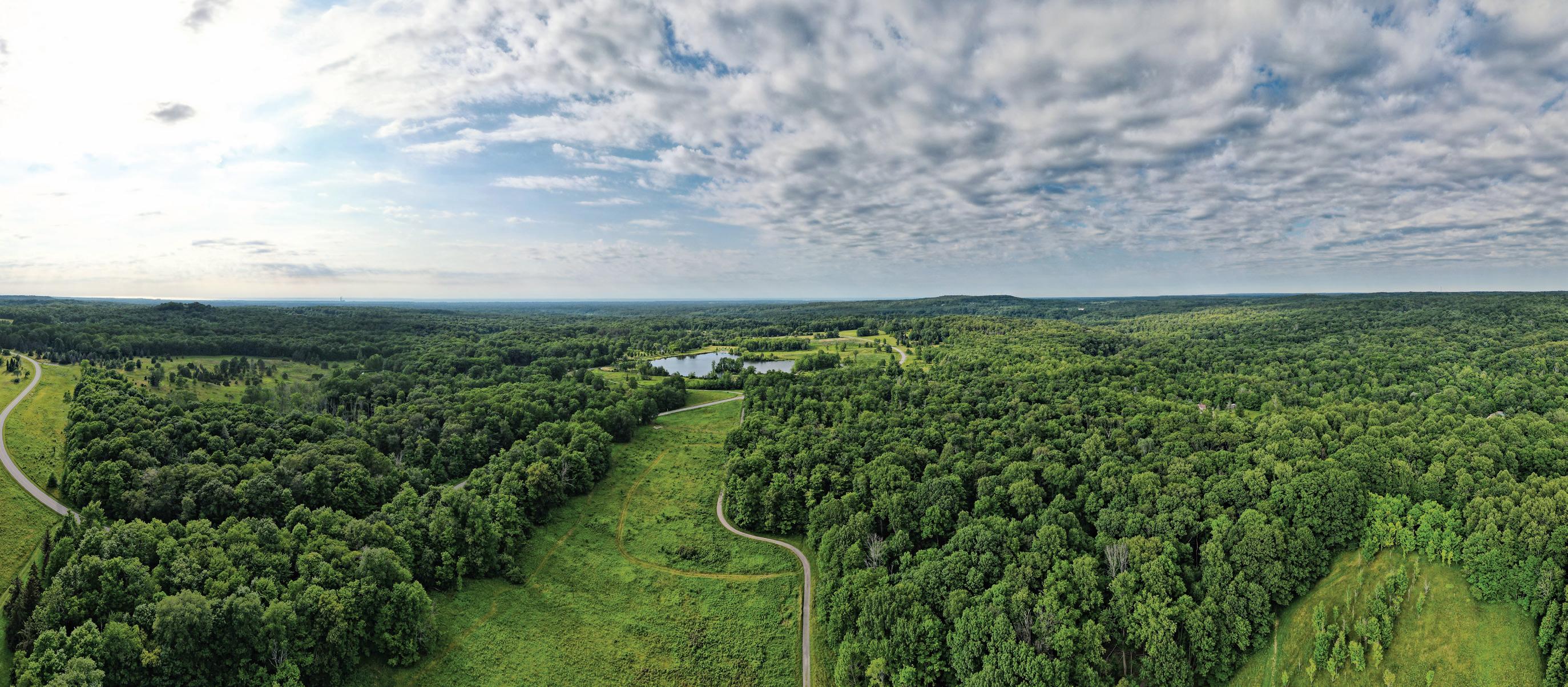
KATHLEEN HEFLIN & JOEL ALPERN

Co-Interim Presidents and CEOs

SUMMER 2023 3
It’s an exciting time at Holden
Favorite Summer Blooms
Members share what flower they love to see blooming at Holden Forests and Gardens during the summer.
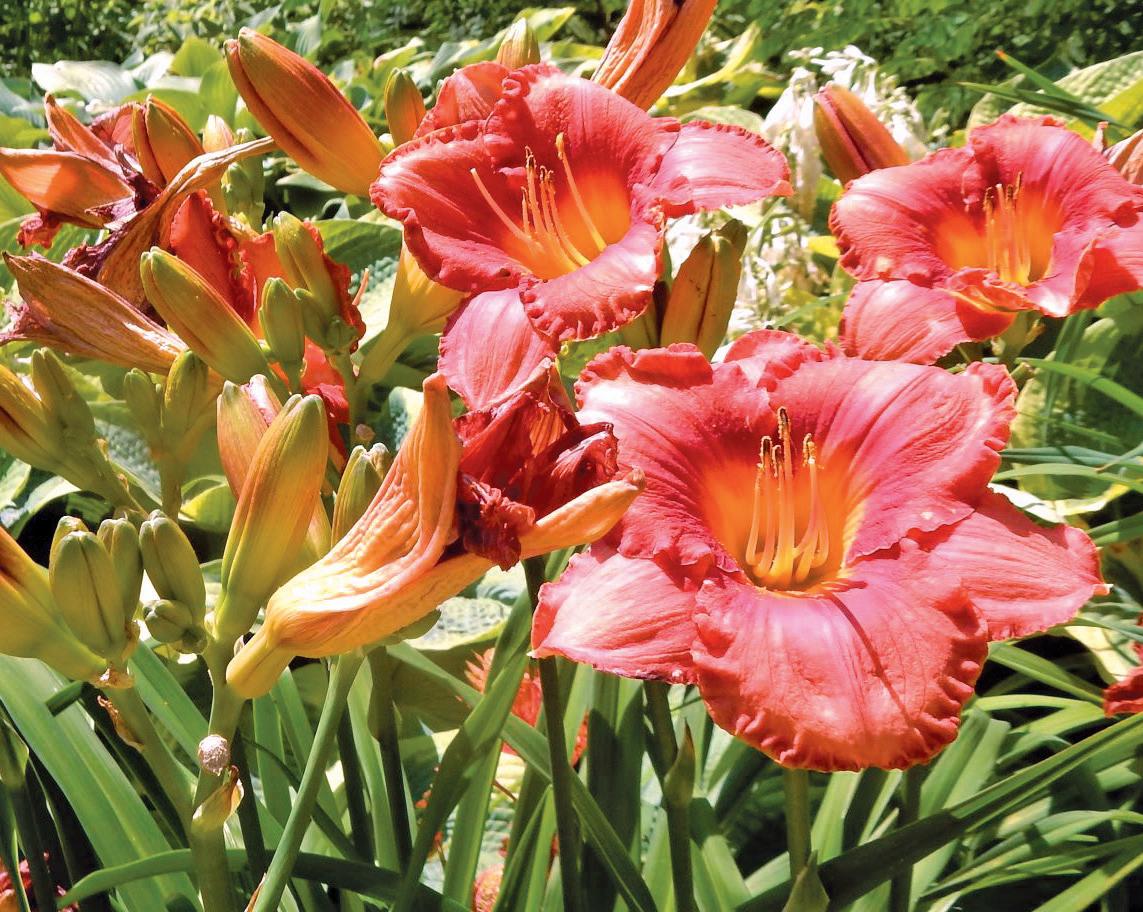

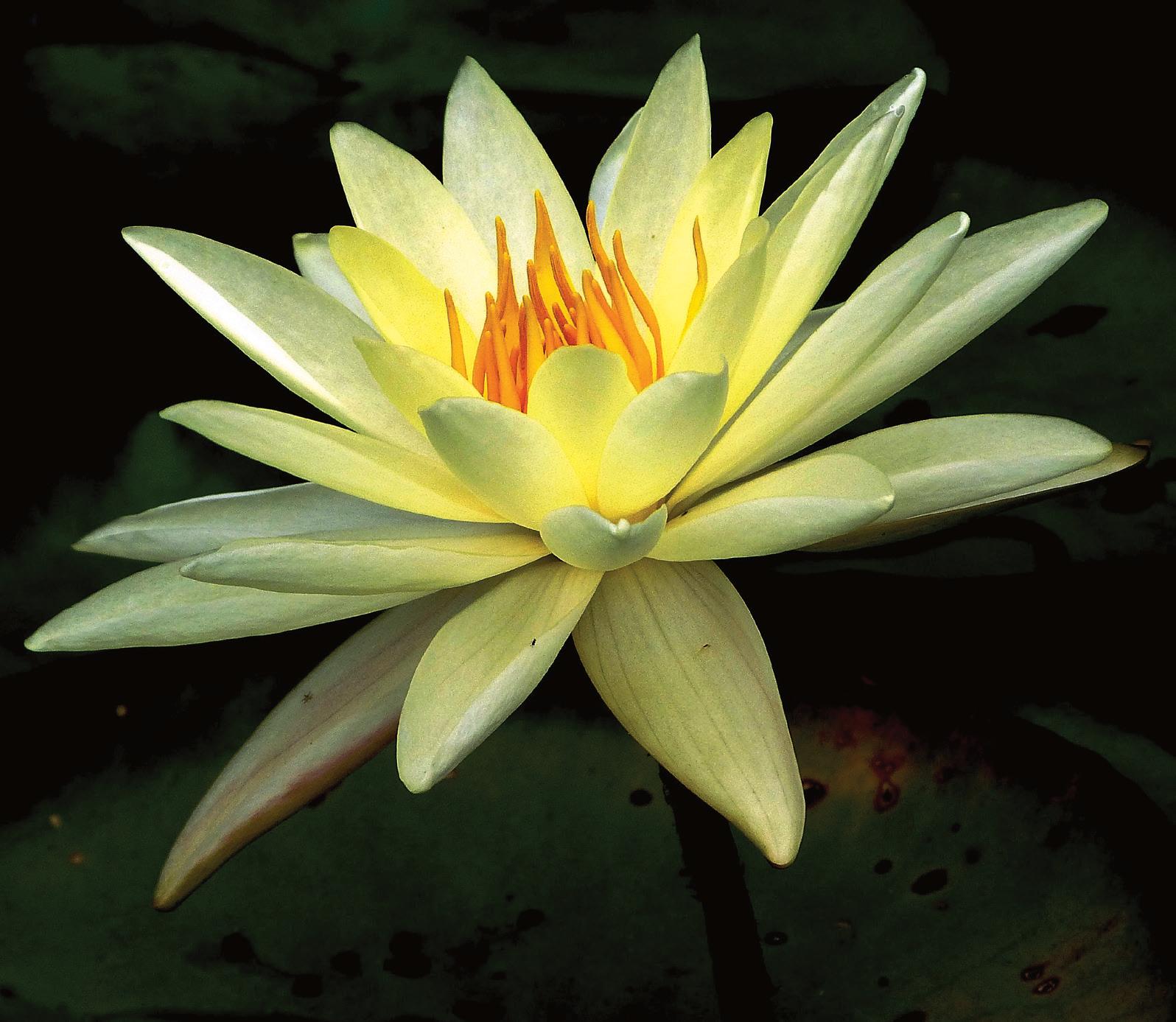
4 FORESTS & GARDENS
Amy Spiesman Daylily
Joe Chrzanowski Purple Coneflower and Black-Eyed Susans
MEMBERSHIP
Ferole Parmelee Water Lilies



SUMMER 2023 5 MEMBERSHIP
Martha Nagy Bee Balm
Emily Zagar Hydrangea
Jennie Sywanyk Peonies
Nature Connects
Toy blocks come alive in Sean Kenney’s magnificent sculptures, on display this summer at the Holden Arboretum.
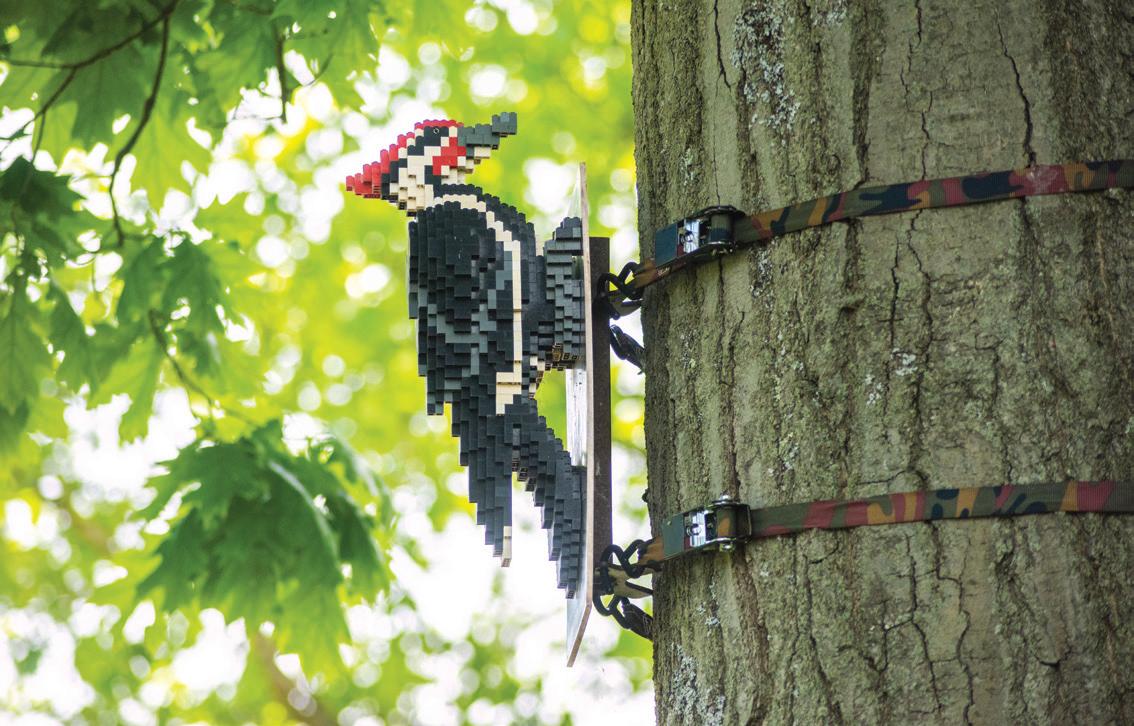

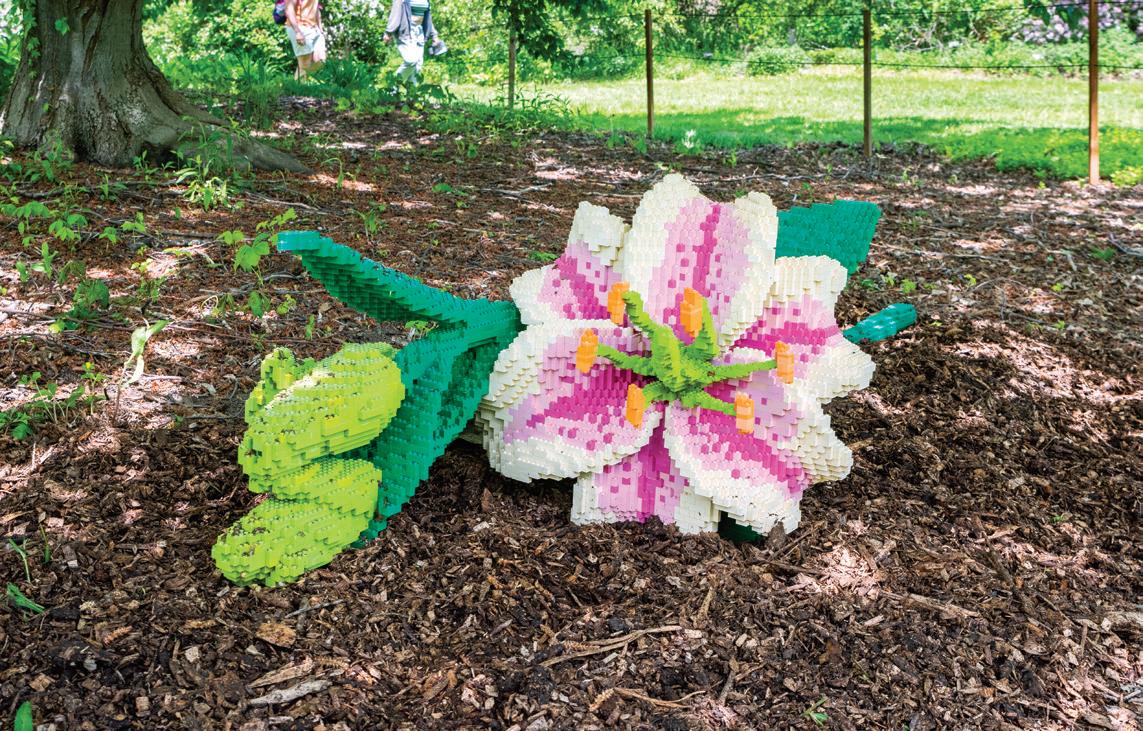
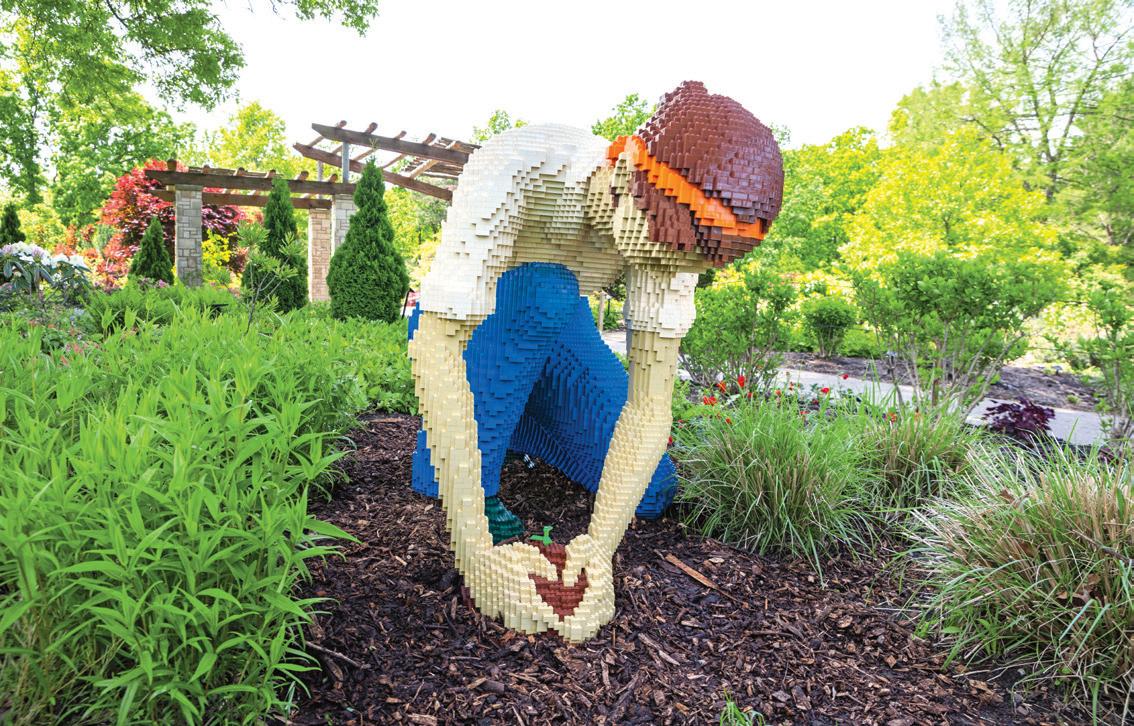

6 FORESTS & GARDENS CAMPUS VISITATION
Duck Family, Display Garden
Kneeling Gardener, Eliot and Linda Paine Rhododendron Discovery Garden
Giant Lily, Display Garden
Praying Mantis, Display Garden
Pileated Woodpecker, Norweb Tree Allée
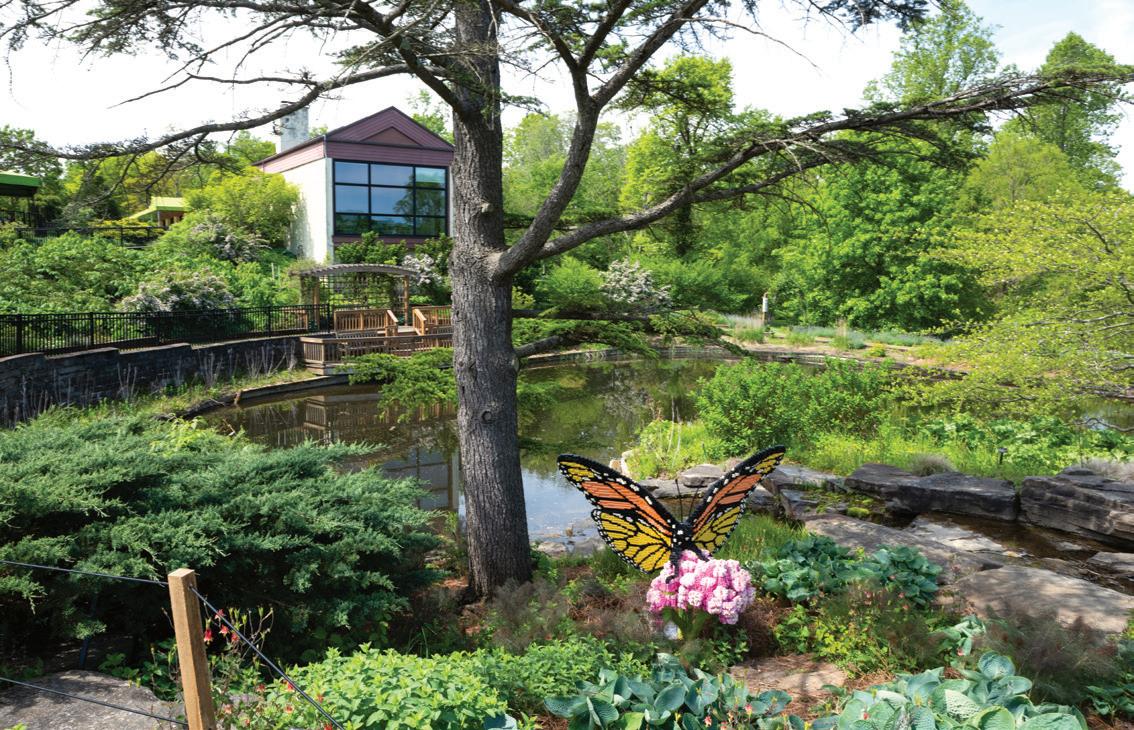




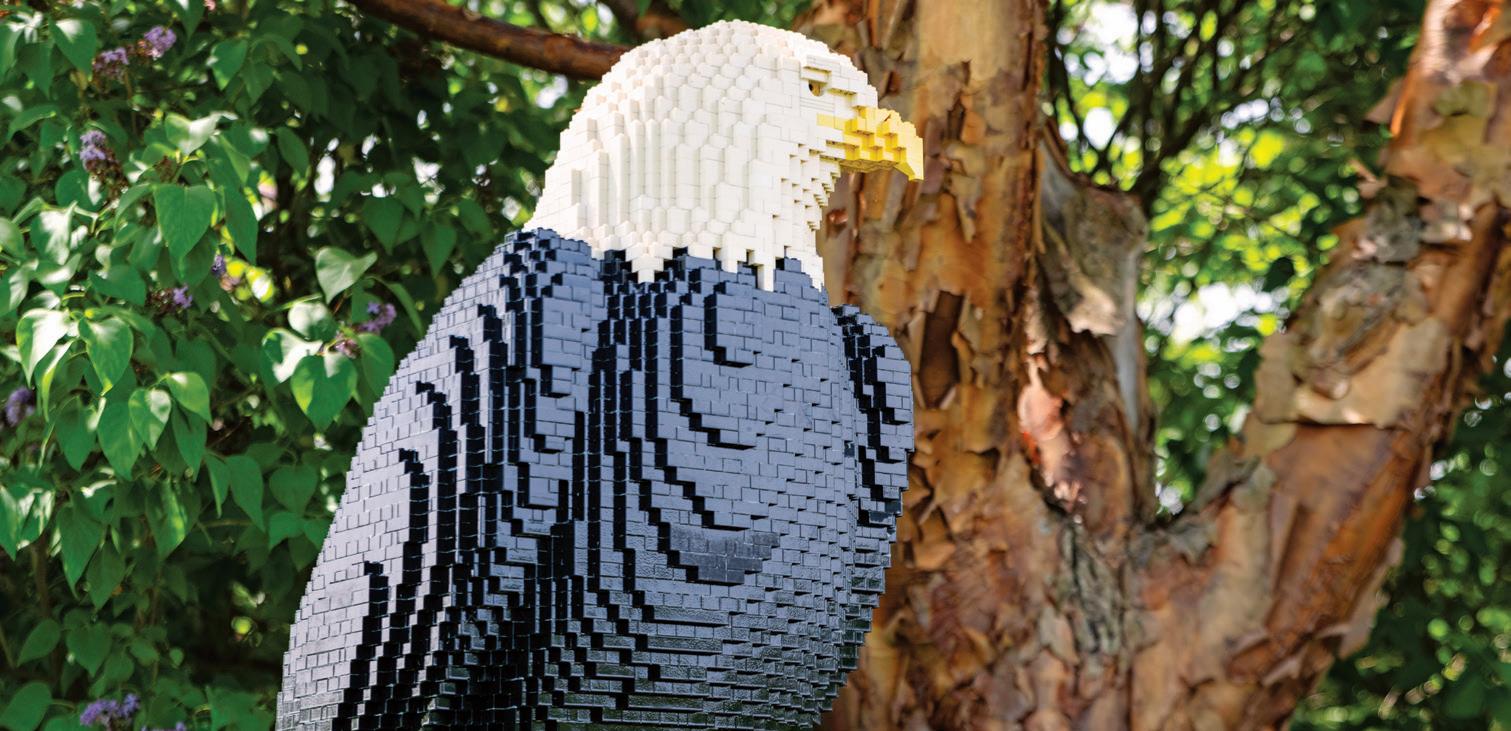
CAMPUS VISITATION SUMMER 2023 7
Monarch Butterfly, Arlene and Arthur S. Holden Jr. Butterfly Garden
Bald Eagle, Display Garden
Birds vs. Squirrels, The Foodie Garden in Memory of Rose M. Kubik
Petals and Perches
More than 400 colorful birdhouses welcome our Cleveland birds to find their home tweet homes this summer at the Cleveland Botanical Garden.
Visit a new exhibit at the Garden this summer and discover which birdhouses are most likely to attract birds and learn more about how birds interact with plants in our garden (and yours)! Learn which plants will attract birds in all four seasons and how to keep birds safe with tips about feeders, houses and baths. This exhibit features birdhouses created by the public, our staff and volunteers using upcycled materials.
Here are some bird-loving tips as we all welcome our feathered friends this summer season.
Gardening for Birds
As human development expands and natural habitats disappear, it is important to protect remaining natural habitats and to make our developed environment as friendly to wildlife as possible. One terrific way to do this at your home is to landscape for wildlife. Planting native plants in your yard protects birds and other wildlife by embracing seasonal cycles and encouraging natural feeding and migration.
Won’t You Be My Neighbor?
Humans can have a big impact on local bird populations. The biggest threats to birds are habitat loss, climate change and predation by domestic cats and invasive species, which are all direct results of human activity. It is important that we take action where we can to protect biodiversity and be responsible stewards of our environment.
Home Tweet Home
While many birds nest on branches, in shrubs or even in gutters, others prefer enclosed spaces. Natural spaces like the hollows of trees or rocks often fit the bill, but there are never enough to go around for these cavitynesters. This is where birdhouses can be useful.
Different birds require different features to make their homes comfortable, such as opening sizes, distance from door to floor, even the location of the house itself — so be sure to do your research when attempting to attract specific birds. In this exhibit we have chosen to display colorful birdhouses, but birds are mostly attracted to simple designs that blend in and help them avoid predators. Be sure to clean out old nesting materials after the breeding season to get ready for next year’s visitors.
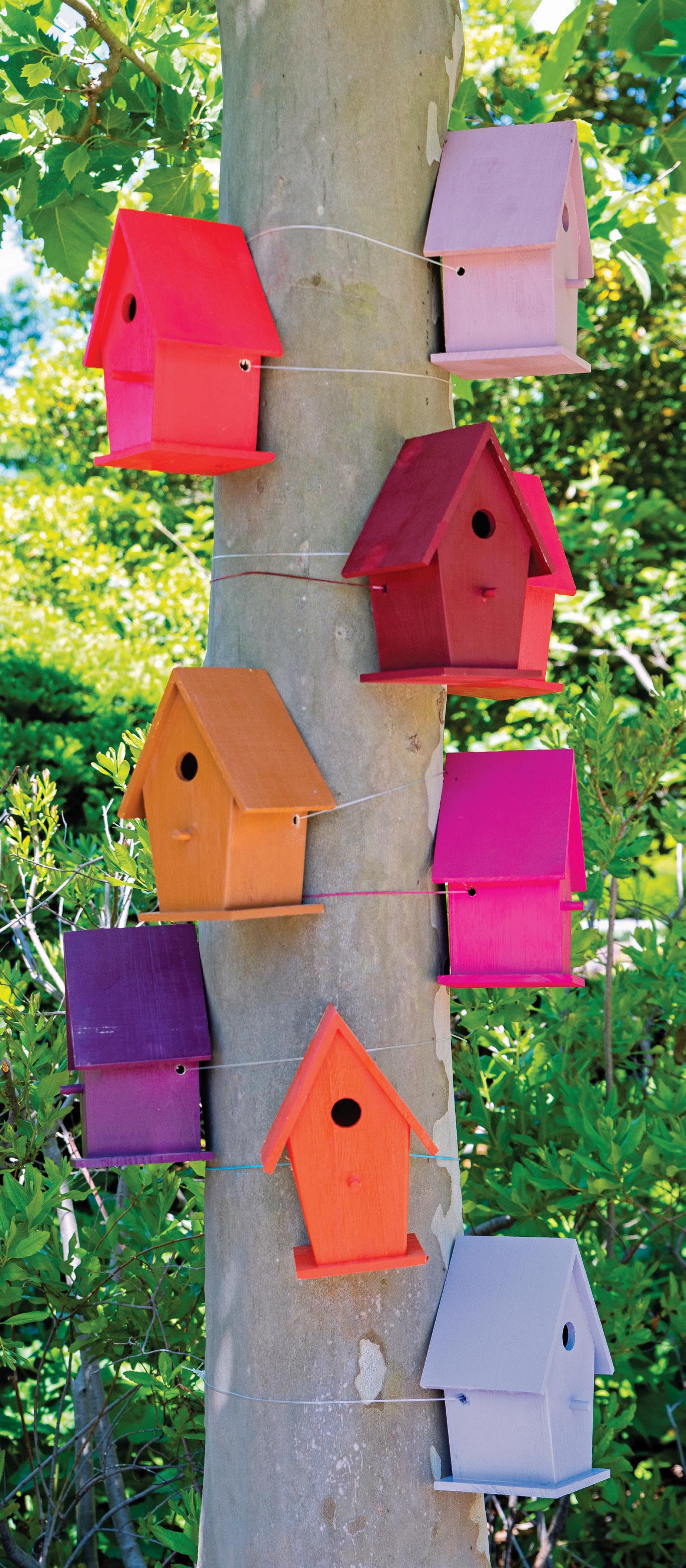
8 FORESTS & GARDENS
A Dangerous Dinner Party?
Bird feeders allow us to enjoy local birds from the comfort of our homes and are a great introduction to the world of birding. There are many styles of feeders and varieties of food that attract different types of birds throughout the year.




While there are many upsides to bird feeders, it is important to also recognize their risks. When birds of separate species are attracted to one feeding source, they are gathering unnaturally in a way that can spread disease. Feeders can impact natural migration. Birds are also more likely to become prey to outdoor cats in the static environments around feeders.
To keep local birds safe, our No. 1 recommendation is to grow native plants in your yard that feed birds naturally. In addition to native landscaping, many of us here at Holden Forests & Gardens still enjoy using feeders and have some tips to help make them safe:
•Use plastic or metal rather than wood for ease of cleaning
•Clean often and thoroughly
•Dry before refilling to prevent mold
•Clean up spilled seed and feces around feeders
Splish Splash
Birdbaths are a beautiful staple in many gardens, and they also provide a vital resource for any wildlife garden. Particularly during the dry summer months it can be difficult for birds to find reliable, accessible sources of clean drinking water — and bird baths can make your garden a popular spot for birds. It’s important to change your birdbath water regularly, clean the birdbath with disinfectant and make sure it is well-rinsed before refilling to prevent diseases.
Plants for Summer Birds
Trees:
•Amelanchier laevis (Allegheny serviceberry); Amelanchier arborea (downy serviceberry) (fruit)
•Prunus serotina (wild black cherry) (fruit)
Vines:
•Bignonia capreolata (crossvine)
•Campsis radicans (trumpet vine)
Shrubs:
•Rosa blanda (smooth rose)
•Ceanothus americanus (New Jersey tea)
•Vaccinium angustifolium (wild lowbush blueberry)
•Clethra alnifolia (summersweet)
Herbs:
•Phlox paniculata (garden phlox)
•Aesclepias tuberosa (butterfly milkweed flowers)
•Monarda didyma (scarlet bee balm)
•Lilium superbum (Turk’s-cap lily)
•Spigelia marilandica (woodland pinkroot)
•Liatris spicata (blazing star)
•Echinacea purpurea (purple coneflower)
SUMMER 2023 9 CAMPUS VISITATION
Inspiration in Bloom
Colorful glasswork and thought-provoking collage make a bold and beautiful statement in the Geis Terrace and Allee.
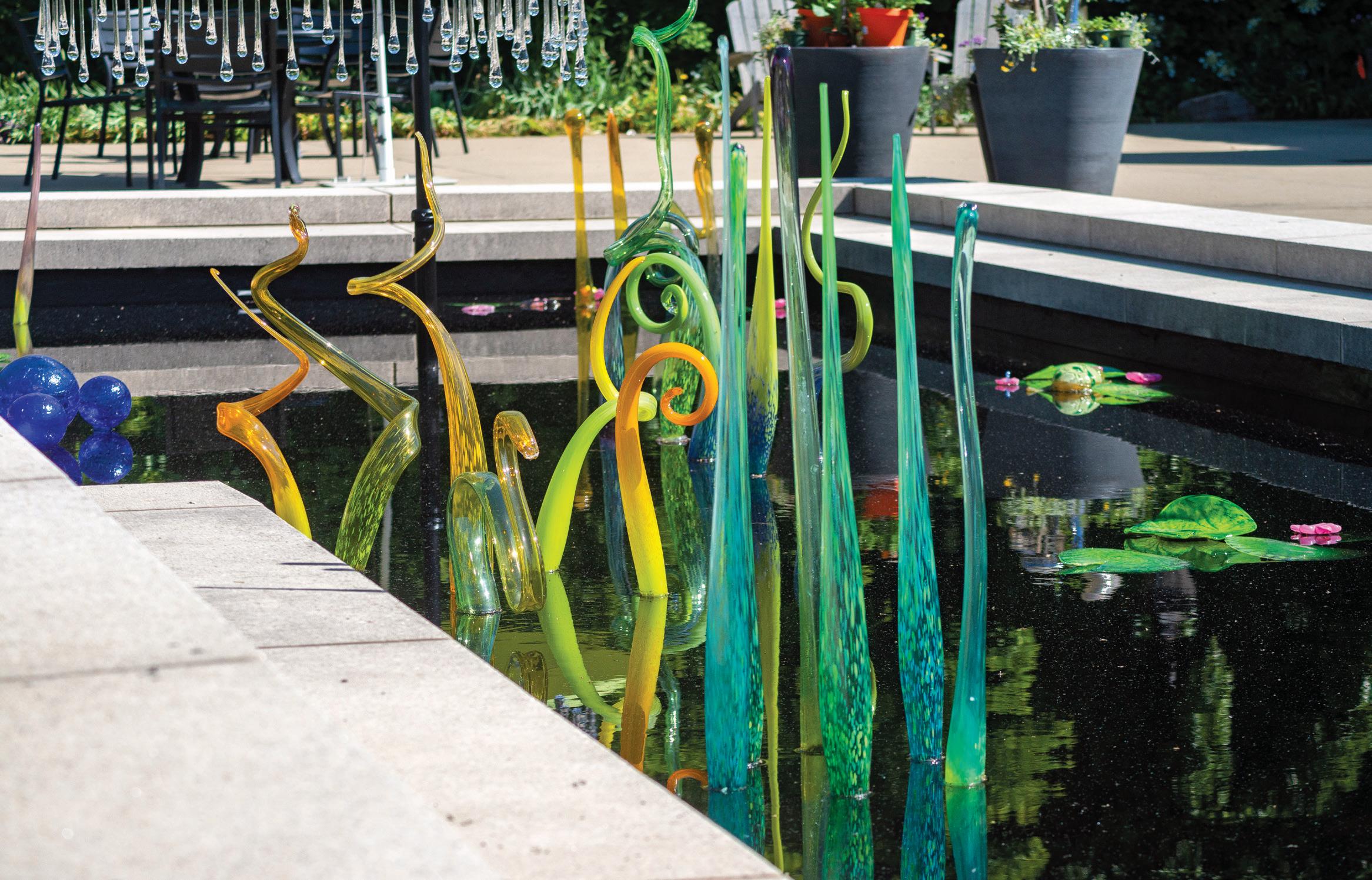 By Kristen Hampshire
By Kristen Hampshire
Creativity and inspiration are in bloom with ethereal and empowering exhibits by local mixed media and glassworks artists in the Geis Terrace and Allee.
The reflecting pool will transform into a garden of colorful, abstract, life-sized trees mingling with more than 200 handblown lily pads that are skimming the water. Meanwhile, a vibrant display of summer annuals co-curated by Horticulturist Rob Dzurec with photographer Asia Armour serves as a backdrop for her In Bloom installation.
“The terrace is an expansive space that demands design with both scale and form,” says Caroline Watson, horticulturist, relating that she has long wished for art in this space. “The medium needs to complement plants rather than stand apart from them.”
Translucent glasswork revealing “hints of plants through it” with organic shapes offers a sense of movement. “Having a completely different texture allows the glass arts and plants to shine without competition for the spotlight,” Watson relates.
Armour’s works celebrating the glamour and grit of Black women who marked history with their accomplishments will also be displayed in the Eppig Gallery. “Making these pieces into ‘living works’ is a step in a different direction for me creatively,” Armour says, noting that an existing In Bloom show is expanding and deepening to offer an impactful visual and learning experience at CBG.
“I want people to really get lost in the works, to feel good — to have the same effect that these women had on the public,” she shares.
GROWN BY GLASS
At Glass Asylum in Chagrin Falls, a studio of eight artists serves as a collaborative community under the direction of founder and artist Chris Crimaldi. His interest in creating translucent glass fixtures for retail and industrial settings — including upscale Cleveland restaurants — was born from the electrical company, Crimaldi and Son, he manages with his father.
Crimaldi is a self-taught glass artist and began blowing glass in 2009 with Rene Culler in her studio in Cleveland’s Glenville neighborhood. He was immediately hooked. Today, Glass Asylum is a premiere teaching facility, active studio and gallery. Artists and guests can create, collaborate and customize in an allaccess setting that hosts events. It is also a dynamic workshop for the studio’s trained talent.
10 FORESTS & GARDENS
“Every day, I am surrounded by a cast of artists who take their work seriously. Each of us brings a different skillset to the process, and we hone that,” Crimaldi says. This community approach is how Glass Asylum designed, created and installed the exhibit in The Terrace reflecting pool.
Five structural glass trees with winding branches with a Dale Chihuly-esque modern interpretation will be “planted” in and around the water. They stand 10 to 12 feet tall and are fabricated from steel and colorful glass. Two of them flank the pool’s fountain.
Artists at Glass Asylum formed about 200 lily pads topped with sculptural flowers, each glass plant ranging in size from 8 to 15 inches in diameter and living in groups of about a half dozen. “We created concrete forms with rods that extend from them to hold up the lily pads,” Crimaldi explains of the complex installation that is equally improvisational.
Because of Crimaldi’s electrical trade experience, equipment and access to facilities, the Glass Asylum can manage largescale installations like this one, along with custom commercial works. Individuals also enlist the studio for functional, memorable and purely aesthetic pieces. Those range from vases and sculptures to memorials, wedding commemoratives and awards such as trophies.
Crimaldi calls the process of creating this exhibit “very organic.”
“It’s true art. It grows. We collaborate — ‘Let’s try this, let’s add this piece here or infuse color into this spot,’” he explains.
The Cleveland Botanical Garden show’s international acclaim is a real coup for the homegrown glass studio. “Every glass artist in the studio had some part in the exhibition to create a magnificent glass display that defines who we are at our studio,” says Crimaldi.

A GARDEN OF GREATS
Asia Armour allows herself the freedom to explore and experiment when creating her mixed-media collages, which are packed with layers of meaning. Most of her work incorporates flowers, plants and foliage. In Bloom stretches these concepts by infusing the botanical backdrop into a celebration of Black women.
Inspired by Andy Warhol’s style when he repurposed Marilyn Monroe’s image, Armour took this iconographic approach to collage works. She highlighted Eartha Kitt, Josephine Baker, Nina Simone, Dorothy Dandridge and Diane Carroll.
“The works I create place their faces against a bed of flowers to give this dreamy state,” Armour describes.
Armour lets her process flow. She begins by collecting photographs, magazine pictures and other found pieces. “I cut them up for hours and lay them out,” she says. “Then I play around with the canvas, and it grows from there.”
Floral designs represent the glamour these Black women role models exude. Each subject was intentionally selected by Armour. “I love everything she is about,” she says of Eartha Kitt. “She is one of the first Black women in history to be on the Silver Screen and play Catwoman.”

A lover of black-and-white films, Armour identifies with the cinema works of Clevelander Dorothy Dandridge. “Briefly, I was a film student,” she reveals.
Armour says she’s proud to introduce a collection of impactful women in a thought-provoking way. “I love nature and plants, and this exhibit offers an opportunity to really mix nature and art,” she says.
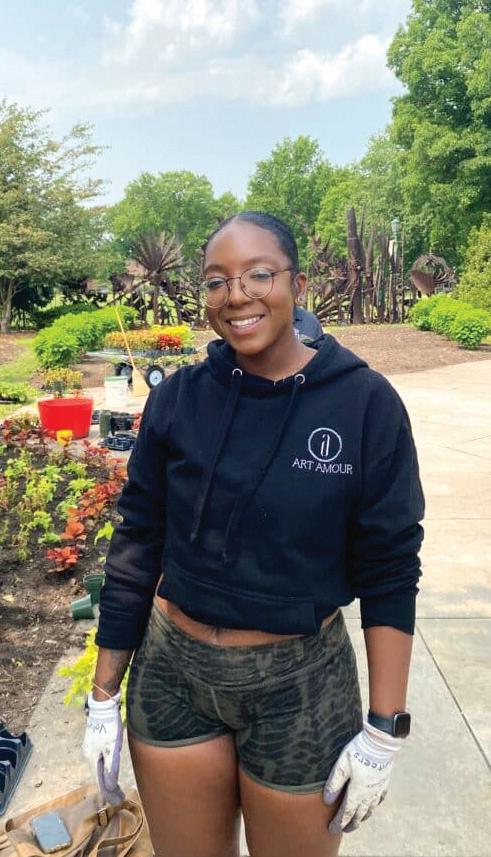
SUMMER 2023 11 CAMPUS VISITATION
Asia Armour artwork
Asia Armour
Animal Care
Holden Forests & Gardens is home to a wide array of wildlife as well as a unique animal collection that requires specialized care.


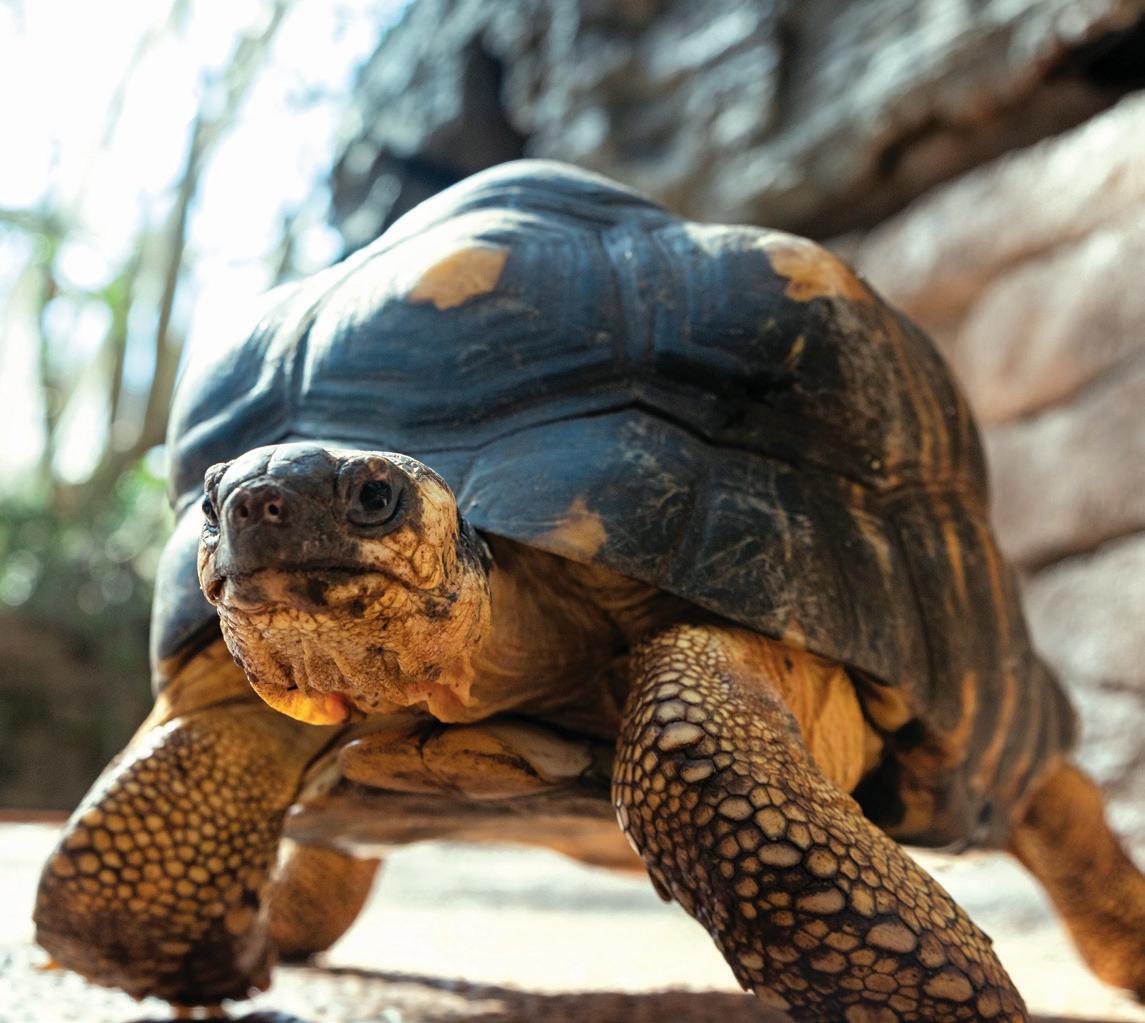
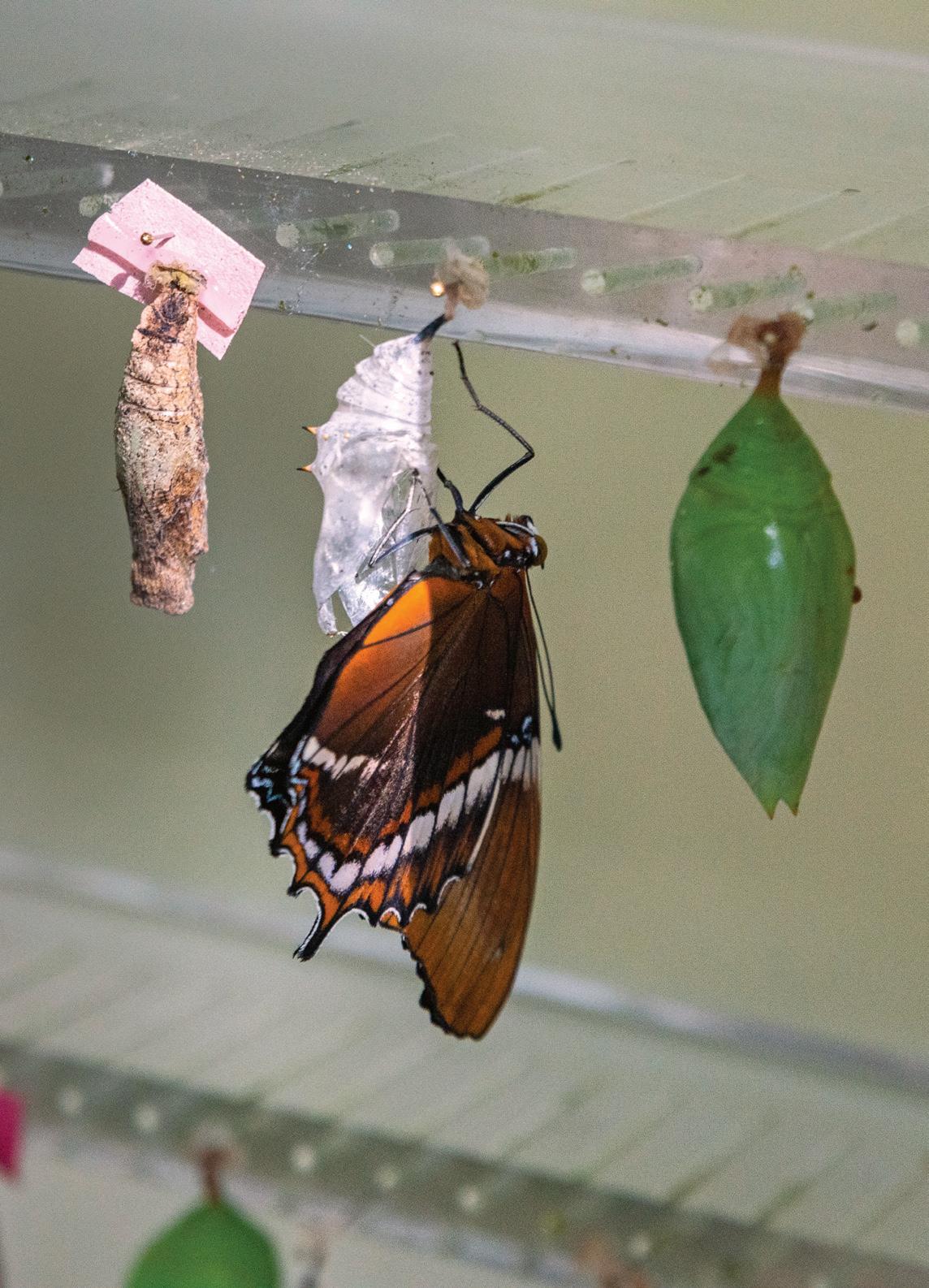
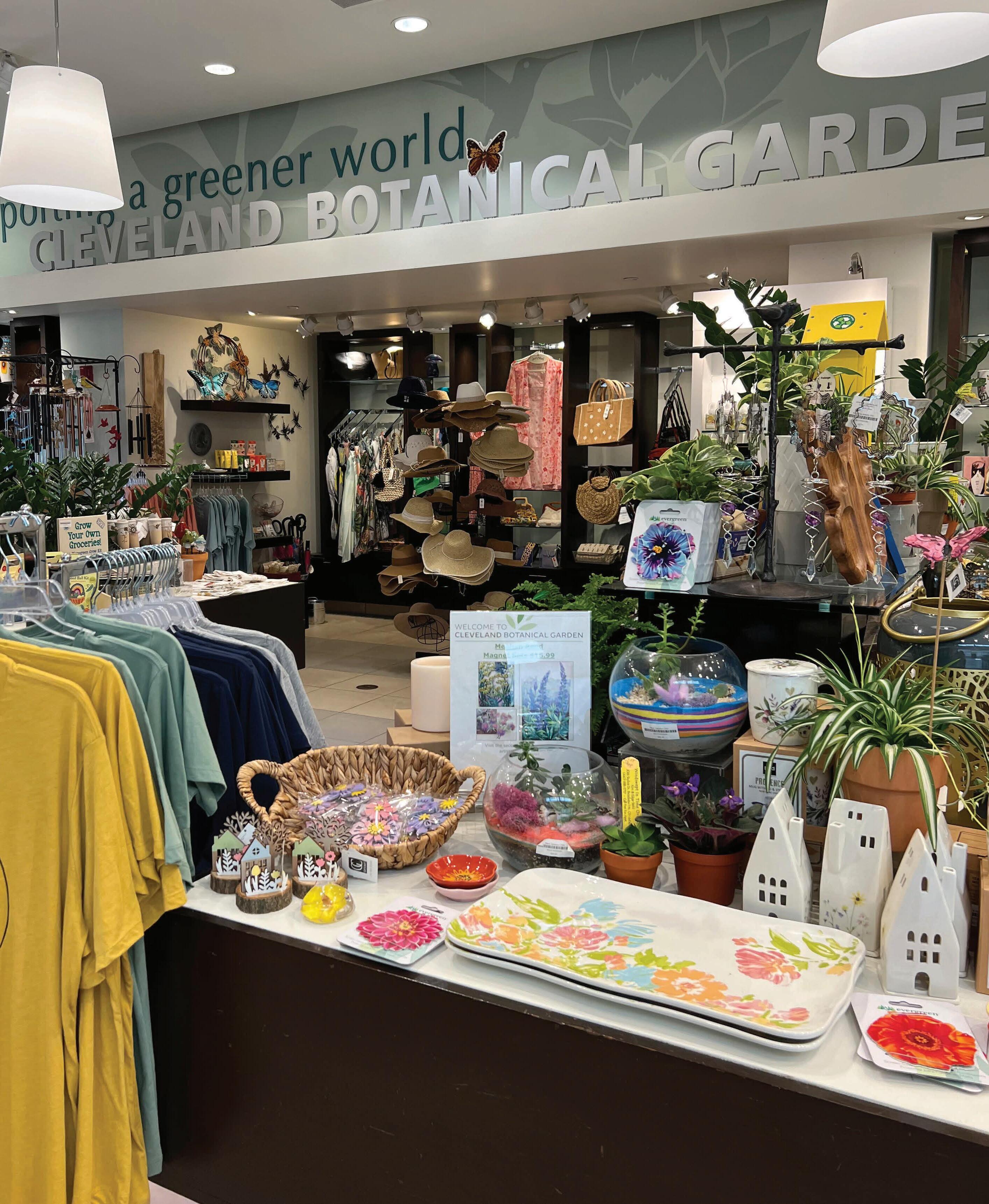 By Matt Edwards
By Matt Edwards
12 FORESTS & GARDENS CAMPUS VISITATION
1. ‘Small’ the radiated tortoise.
2. Giving ‘Small’ the radiated tortoise a shell shining.
3. Tithorea tarricina pupa.
1 4 2 3
4. Siproeta epaphus emerging from pupa.

Visit the Garden Store at Cleveland Botanical Garden and the Treehouse Store at the Holden Arboretum to browse our fabulous collection of botanical items. Check holdenfg.org for store hours.
5. Mark, the panther chameleon.

6. Changing the bird diets in the Costa Rica biome.


7. Bob, the panther chameleon eating a cricket.
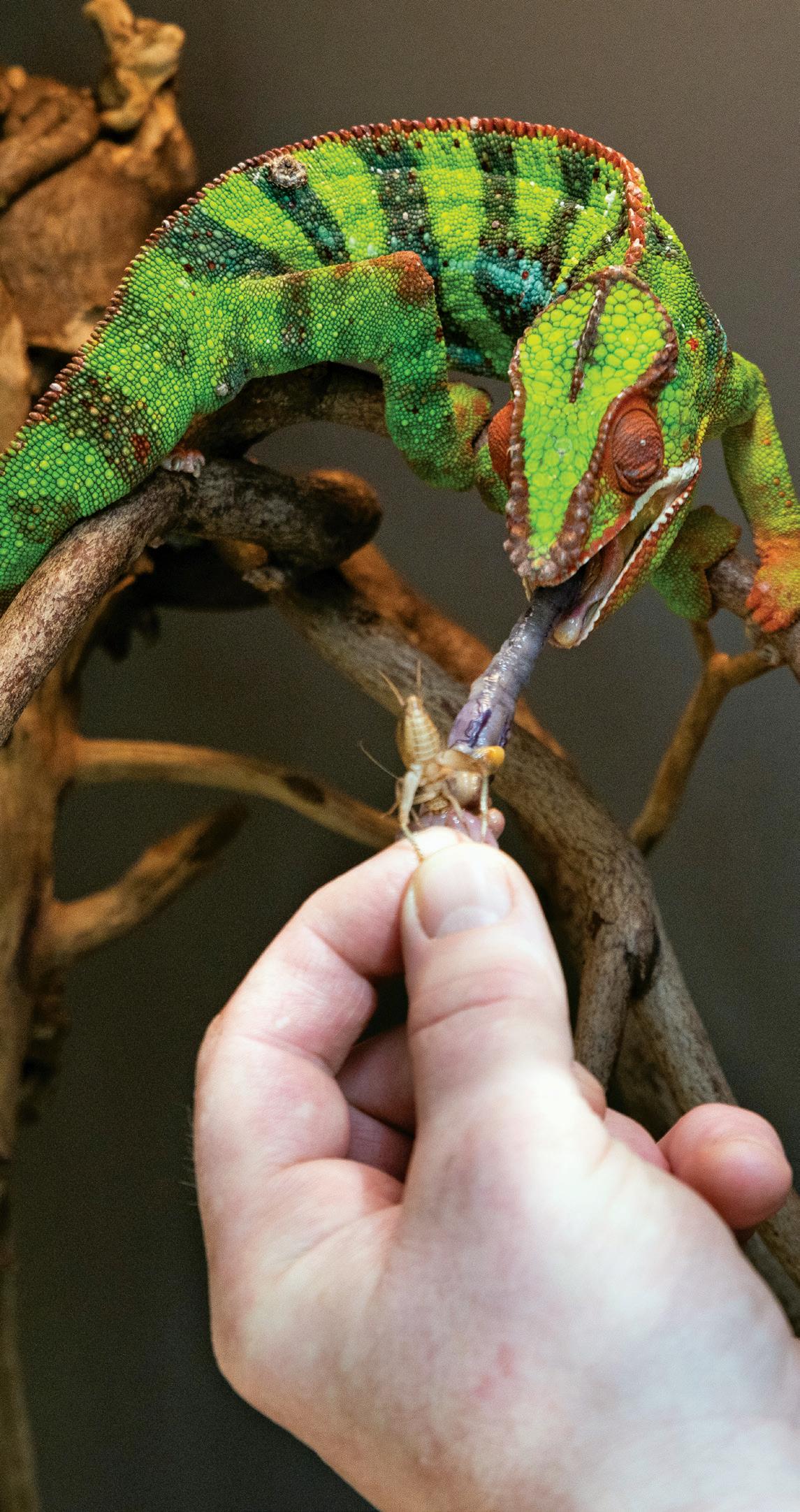
14 FORESTS & GARDENS CAMPUS VISITATION
5 7 6

Contact Halle Scotese 216.707.2846 Your event deserves a beautiful setting
Ryan Harris, RH Imagery
Showing Love through Eternal Support
A donation ensures that Gay Cull Addicott’s legacy will endure at Holden Forests & Gardens.
By Chris Keeney, Major Gifts Officer
Gay Cull Addicott was an iconic Clevelander who left behind a legacy that will reverberate across our region for decades. She was involved in politics, served on numerous boards and was passionate about the City of Cleveland and its institutions, like the Holden Arboretum, that make it such a unique place. Her husband Ed Addicott noted that her philanthropy was guided by a simple principle.
“What you love, you support,” he recalls Gay saying frequently.
Gay’s love for the Holden Arboretum grew even deeper roots through her $1 million bequest that the organization received after her passing last year. With a lifelong passion for gardening and plants, Gay was first drawn to Holden for simple aesthetics, but that led to a deeper bond that will last forever.
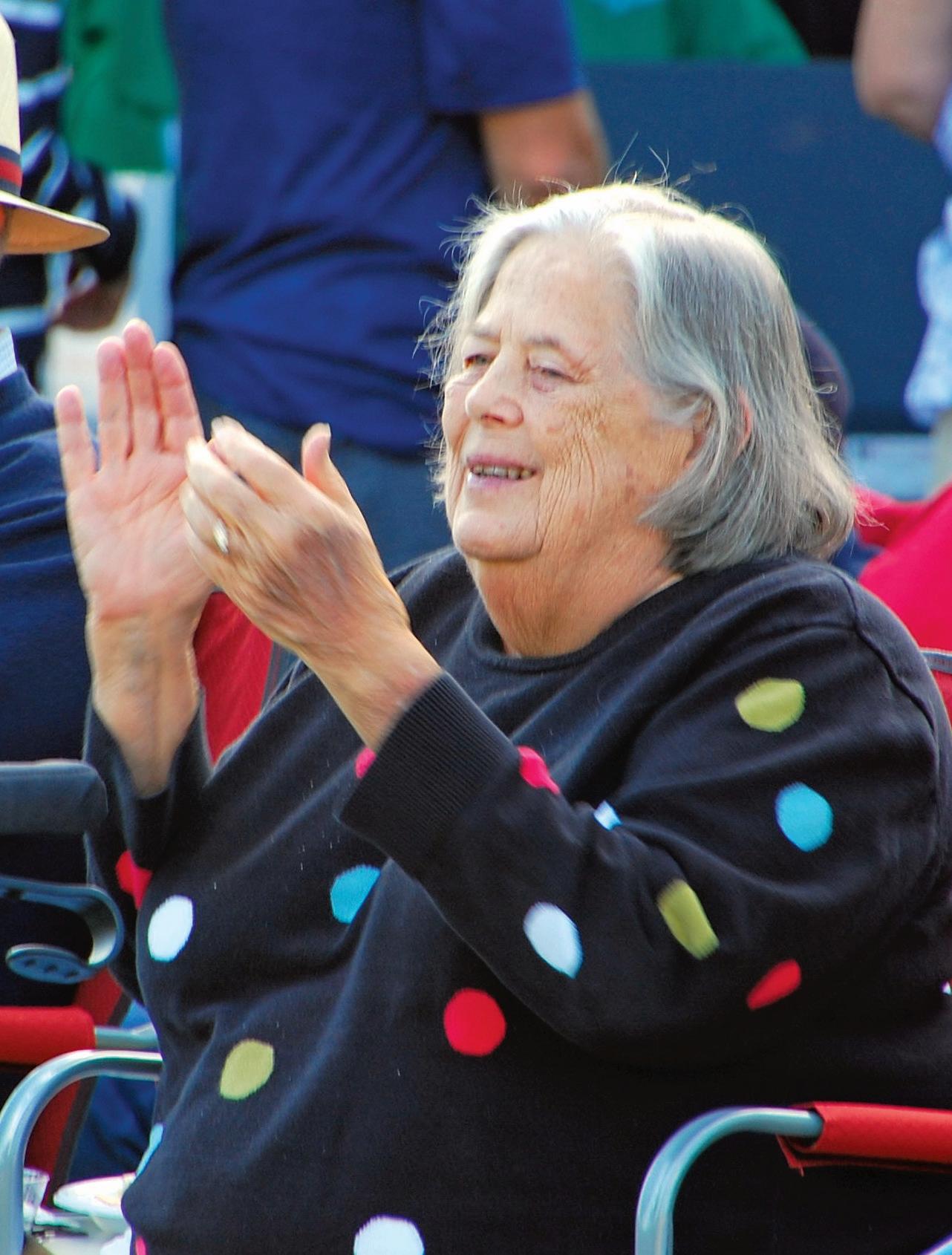
“My mom was a lover of things that were beautiful,” says son Stephen Ban. “She knew the importance of taking a break from the noise and bustle of the world to see the beauty.”
Ed echoes Stephen’s sentiments with hopes that Gay’s estate gift will “support the beauty of springtime at the Holden Arboretum.”
The intersection of natural beauty and music were a sweet spot for Gay. In 2010, Gay and Ed established an endowment to support performances by students from the Cleveland Institute of Music (CIM) at Holden Arboretum. Each summer, the sounds of classical music blend with blooming flowers and towering trees. This endowment was later expanded to include performances by CIM students at the Cleveland Botanical Garden.
“The marriage of the beauty of nature and beauty of music were magic to my mother,” recalls Stephen. “The Holden Arboretum and the Cleveland Institute of Music were two of her loves. Pairing those two loves together only made it better.”
Recalling the concerts that took place over the years, Ed marvels at a streak of good luck that Gay had.
“Every time we came, the weather was just wonderful,” says Ed. “It only rained once in all the years. We sit here on Lake Erie during the summer so it can be tough, and it came out wonderfully.”
Bringing the incredibly talented performers to the Holden Arboretum was a highlight for Gay.
While taking a long look across the Arlene and Arthur S. Holden Jr. Butterfly Garden, Ed remarks, “I really do think the high point for Gay was the combination of Holden Arboretum and CIM. Their students come from all over the world. They’re ridiculously talented and this takes them outside of University Circle for a while. Nothing down there compares to [the Holden Arboretum]. They can come out here in the silence and serenity.”
16 FORESTS & GARDENS
DEVELOPMENT
One concert stands out. It was a picturesque evening, and a hot air balloon was visible in the distance while the classical music filled the remaining airspace. The investment that Ed and Gay made to the concert series paid off that night alone.
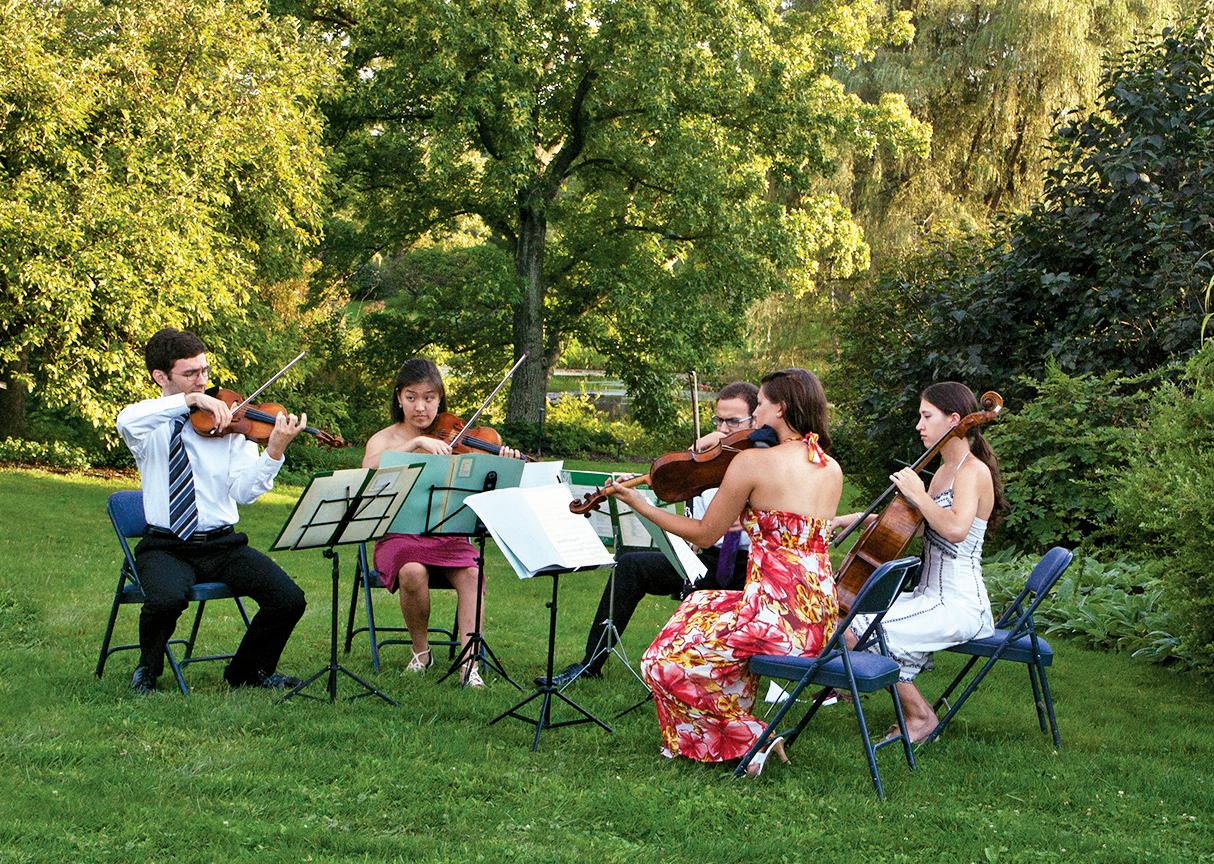

“It was a memory one holds forever,” Ed recalls. “It was as lovely as could be, and it was just very fitting. It was a perfect night.”
When recalling his mother’s passion for Cleveland and its institutions, Stephen finds an animated way to discuss her commitment.
“There was a comic strip that asked a mom how she divides her love among all her children,” Stephen recalls. “The mom replied ‘I don’t divide it, I multiply it. That’s emblematic of how she ticked and how she gave back to Cleveland.”
Gay’s love of Holden Arboretum was expressed not only through her lifetime of giving but her $1 million bequest that will preserve the beauty she loves forever. That love and commitment will have a multiplying effect as families, concert goers and outdoor enthusiasts visit the Holden Arboretum for years to come.

MEET THE STAFF
Chris Keeney joined Holden Forests & Gardens in February 2021 as the Major Gifts Officer and is based at the Cleveland Botanical Garden. Prior to HF&G, Chris was the Director of Development at EDWINS Leadership & Restaurant Institute, and he has also worked at the United Way of Greater Cleveland and the Cleveland Metropolitan School District. Chris looks forward to building the culture of philanthropy at HF&G and meeting donors and members.
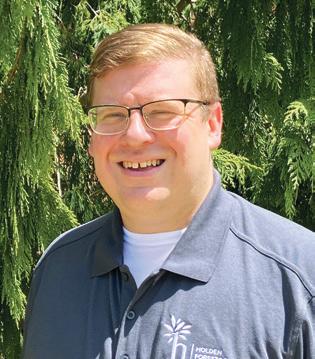
SUMMER 2023 17
Cleveland Institute of Music students at a summer concert on the Gardner Lakeside Terrace at the Holden Arboretum.
The Display Garden at the Holden Arboretum.
DEVELOPMENT
Performance by Cleveland Institute of Music students at the Holden Arboretum.
By Ellie Rial, Donor Stewardship & Events Manager

18 FORESTS & GARDENS EVENTS
of the Summer Join us for a familyfriendly picnic in support of plants, trees, and the benefits they provide Northeast Ohio.
Picnic
It’s that time of year! Holden Forests & Gardens invites you to an evening among the flora and fauna at Twilight at the Arboretum on Saturday, July 15, 2023, from 5:30 to 8:30 p.m. Twilight is our only benefit of the year and helps to raise money for our mission programs.
Tickets are on sale through Saturday, July 1 at holdenfg.org. Adult tickets are $150, children are $35.
Join us for an elevated picnic dinner by Spice Catering Co., live music and entertainment for the whole family, as well as the seasonal outdoor exhibition Sean Kenney's Nature Connects Made with LEGO® Bricks. See stilt walkers, a live animal program featuring Holden Forests & Gardens exotic critters, a silent auction featuring one-of-a-kind Holden Forests & Gardens experiences, live plants and more!
Be sure to bring a picnic blanket or camp chairs, wear comfortable clothing and shoes, and don’t forget to bring a sense of adventure as you explore the grounds! This event is held rain or shine, with the exception of highly inclement weather.
New this year, a VIP ticket level features early event access at 4:30 p.m., complimentary valet parking, limited table seating, in-and-out privileges to an adult-only outdoor lounge, open bar, additional musical entertainment and food course, and special recognition in the event program. VIP tickets cost $275.
Dance the night away at Corning Lake with Sunshine Daydream! This funky dance party band from Northeast Ohio specializes in performing Grateful Dead and Jerry Garcia Band music in a refreshing up-tempo style.
As you take in the beauty of the arboretum grounds, pick your favorite picnic spot and enjoy a delicious meal provided by Spice Catering Co., whose specialty is using the best seasonal and local ingredients and facilitating fine dining experiences in the great outdoors.
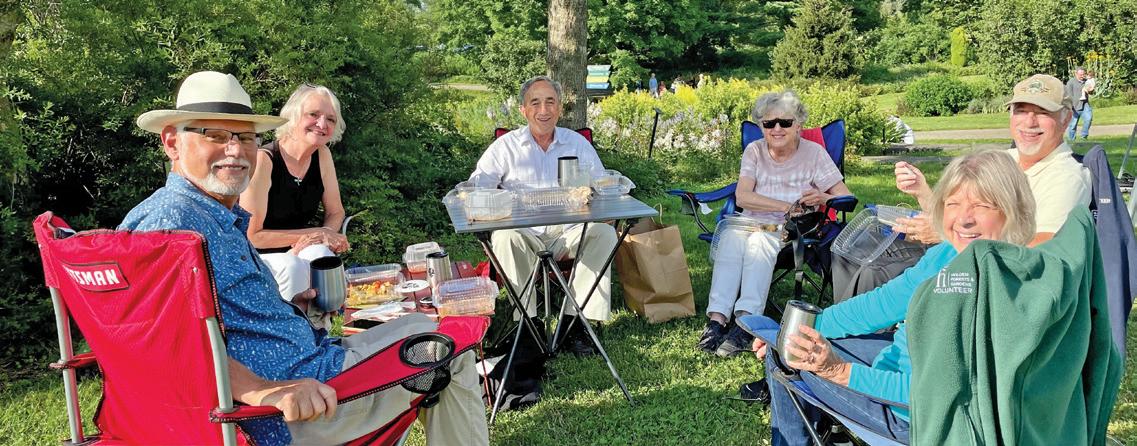
Main Menu: Marinated grilled chicken, Rainbow Farms
cucumber salad and mixed summer berry + oat crisp.
Kids Menu: Panko-crusted chicken tenders, house-made potato chips and a chocolate chip cookie.
MEET THE STAFF
See our new exhibit. Sean Kenney’s Nature Connects Made with LEGO ® Bricks features more than a dozen colorful creations that will pop out of garden and trail landscapes creating a magical new world at the arboretum. Be greeted by a giant monarch butterfly, a gorgeous lily, a huge hummingbird pollinating a flower and nearly a dozen more delightful creations.
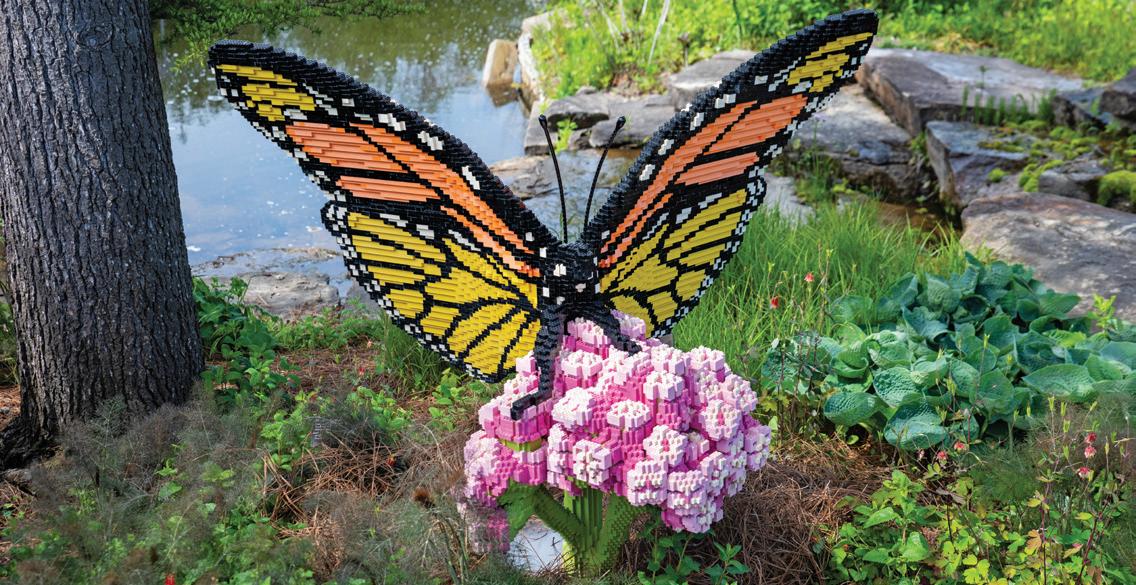
Sunset on the Canopy Walk or Emergent Tower
Experience the Canopy Walk and Emergent Tower like never before during the evening hours at Twilight. Climb to the top of the Emergent Tower just before dusk to see a 360 degree view of the sunset over the arboretum campus.

For event sponsorship opportunities, contact Samantha Lengel at 216-721-1600 ext. 125 or slengel@holdenfg.org to become a sponsor for Twilight at the Arboretum.
Ellie Rial has worked at HF&G for four years and started as the Donor Stewardship and Events Manager in early 2022. Before that, she worked as the Associate Director of Public Programs. She has spent her career working for nonprofit conservation groups in Cleveland and Montana, with a specific emphasis on watershed health and water resources. Ellie has a BA in Environmental Studies and an MS in Natural Resource Management, both from the University of Montana.

SUMMER 2023 19 EVENTS
Delicious Picnic Dinner Provided by Spice Catering Co.
Sean Kenney’s Nature Connects Made with LEGO® Bricks
Outdoor Live
Sunshine
Enjoy
Music with
Daydream
Seed Station
By Anna Funk, Science
In January, a crane dropped a fully loaded shipping container into the Holden Arboretum. But it wasn’t full of goods: The container had been finished into a fully-operational laboratory and storage facility, ready to study, process and stock large quantities of tree seeds.
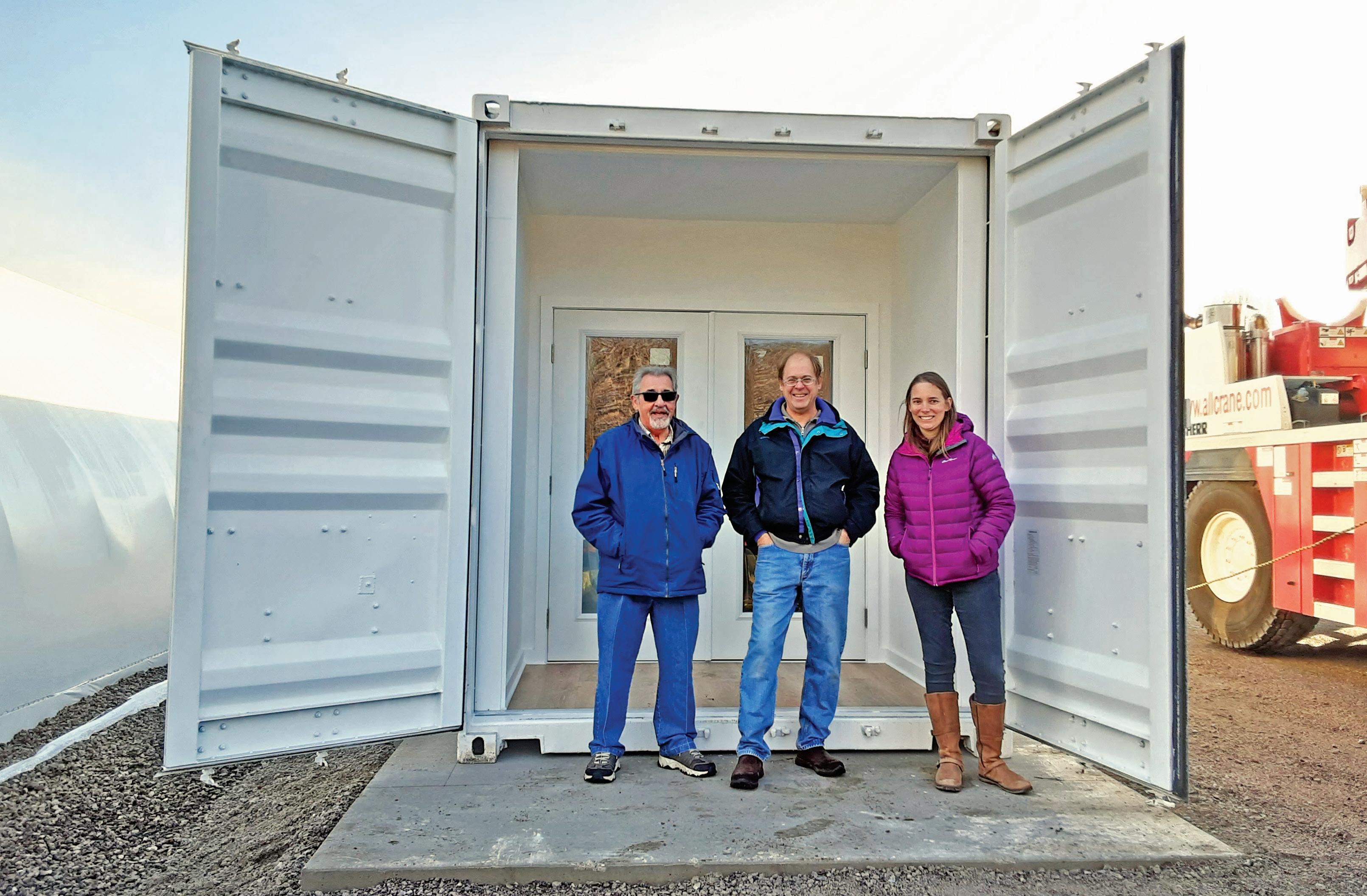
The new seed bank isn’t like others you might have heard of — such as the Svalbard Global Seed Vault in Norway, which preserves biodiversity in preparation for future catastrophe. As David Burke, PhD, vice president of science & conservation at Holden Forests & Gardens puts it, Holden’s new bank is more like a Seed Savers Exchange — a place to collect seeds, process them, store them and, most importantly, share them. The goal? “To catalyze reforestation throughout our region as a way to combat climate change,” says Burke.
Reforestation is the best natural solution for climate change mitigation in the U.S., and over one third of this potential lies in the northeast. Trees remove carbon from the atmosphere, turning it into their plant tissues. According to a report from The Nature Conservancy, natural climate solutions like these,
if instituted, could mitigate up to 21% of our country’s emissions by 2025. But a major bottleneck in these efforts is actually sourcing seeds and seedlings. The question is where all these trees we’re supposed to plant are going to come from.
Enter Terraformation, a company that runs a “Seed to Carbon Forest Accelerator” that helps organizations like Holden speed up and scale up reforestation efforts. It approached Holden about getting a seed bank last year. Thanks to a gift from the Parker Hannifin Foundation to set up the seed bank and an additional $335,000 in Congressionally Directed Spending that was approved for Holden’s Forest Resiliency and Conservation and Canopy Coverage Expansion Project in December, the project is well underway. The funding was sponsored by U.S. Senator Sherrod Brown.
From the outside, the big white box is rather unassuming. Inside the glass doors, the lab space superficially resembles a galley kitchen — a long narrow space filled with cabinets, a sink, fridge and freezer. At the time of this writing, no one’s home, but perhaps as you’re reading, the new seed bank technician leading the efforts
20 FORESTS & GARDENS RESEARCH
Holden’s new seed bank project forms the core of new climate-saving reforestation efforts across the region.
Communication Specialist
Al Picciano, Manager of Facilities; David Burke, VP of Science & Conservation and Katie Stuble, Plant Biologist & Research Chair
will be busy at work, cleaning seeds to prepare them for storage, or even preparing an outgoing package ready for planting.
In addition to serving as a waystation for seeds collected and distributed for restoration, the new seed lab provides valuable new workspace for the Great Lakes Basin Forest Health Collaborative (GLBFHC). It’s another Holden initiative that is working to find, test and breed pest-resistant trees like ash that can survive emerald ash borers. The new seed bank program also provides training and other opportunities for additional staff, both in the bank itself as well as other Holden departments like Urban Forestry or the Tree Core program.
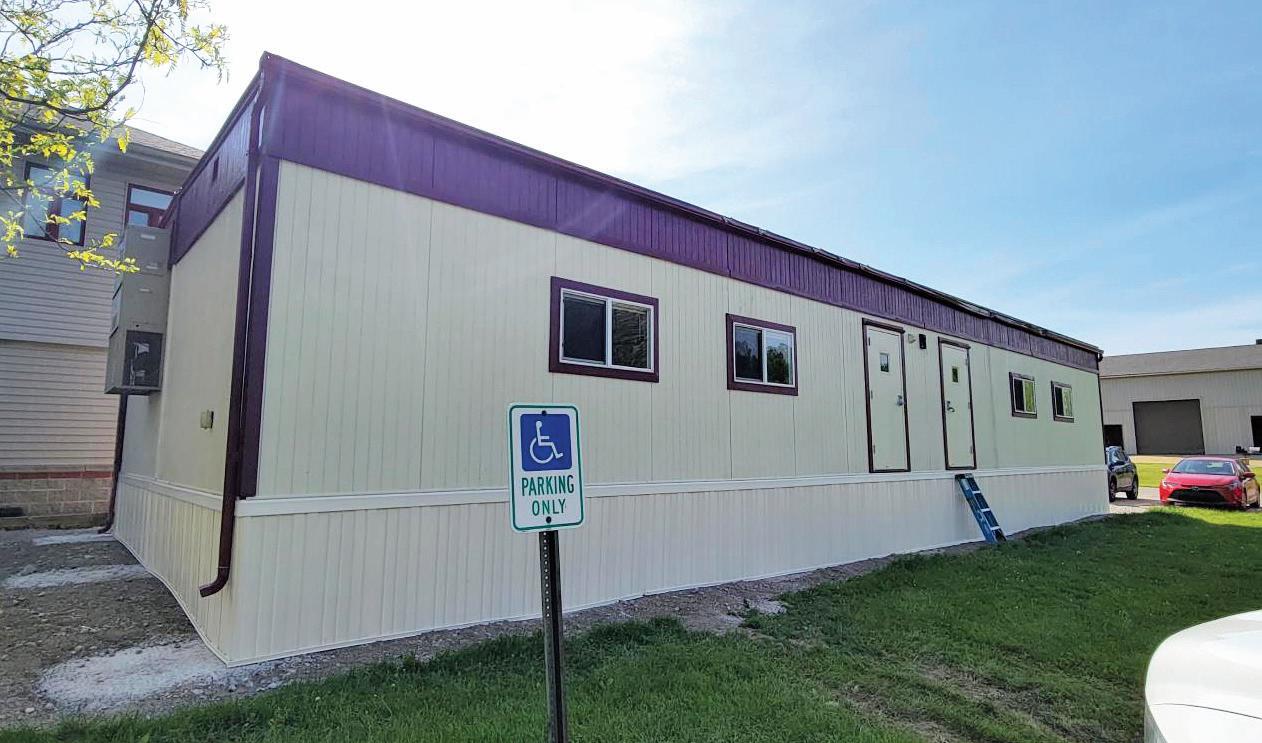
Holden will do some of the seed collecting itself, but such a large undertaking will require the involvement of many organizations across the region. It’s essential that the seeds collected are locally adapted to the region so they’re suitable for planting in our climate. Luckily, partners are already ready to help. These same organizations are likely candidates for who will put the seeds to use in the future: nonprofits, government agencies like ODNR, Cleveland Metroparks, and the like.
The seeds won’t only be used for large-scale, climate-mitigating reforestation efforts. “We’re also interested in reforesting ‘The Forest City,’ as Cleveland is sometimes called,” says Burke. Although climate is a core motivation, planting trees in cities is a great way to combat the effects of climate change, including urban heat island effects. Trees provide shade and cool cities, which in coming decades will be increasingly critical services for city residents.

Widespread tree planting also helps with the other crisis we’re dealing with globally — the biodiversity crisis. Species are being lost on scales never before seen by humanity. For instance, between 1970 and 2019 North America lost upward of 3 billion birds, or 29% of their former abundance. And that’s only birds.

“We can advocate for climate change being a problem that we need to address, and as an organization we can focus on taking action through trees,” says Burke. “We can manage our forests differently, and we can reforest areas that are suitable for forest as a climate mitigation strategy. That also helps mitigate the loss of biodiversity. At Holden, we're perfectly positioned to do this.”
MEET THE STAFF
Anna Funk is the Science Communication Specialist for Holden Forests & Gardens. She earned her Ph.D. studying prairie restoration before leaving the research world to help tell scientists’ stories. Today, she wears many hats, freelancing as a writer, editor, journalist and more — anything that lets her share her appreciation of science and its impact with others.

SUMMER 2023 21 RESEARCH
Seed Bank container is delivered to the Long Science Center
White ash seeds being pruned by Rachel Kappler at the Holden Arboretum. The seeds will be dried and stored in a cooler for future research.
Check It Out!
Explore our libraries to learn more about the great outdoors.
By Marisha Sullivan, Librarian
Have you ever been all the way to the back of the Botanical Gardens by the old East Boulevard entrance? Or perhaps you stopped in the Visitor’s Center at the Arboretum to renew your membership and caught a glimpse of some books in a room next to the desk. Either way, you’ve found our libraries! Yes, there are libraries at both locations, though they’ve been a bit quiet for the last few years. Now that we’re getting back on our feet, we thought it was high time to (re)introduce our spaces.

Two locations, one mission, infinite learning
While it may not seem intuitive to have libraries at a public garden or arboretum, our libraries serve as the hub of a lot of services and opportunities for both recreation and education. Our libraries are great for when you want to enrich your visit with


a deeper exploration of the world of plants and trees or when you’ve been exploring for maybe a little longer than anticipated and want to take a rest in a welcoming and calming space.
Each library has a full circulating collection available for check out to members, volunteers and staff; an organizational archive that documents our history; and special collections that serve to provide important historical context for our work here at HF&G. We also have magazines and journals to help keep you up to date with the latest news in the world of plants. As the information hub for HF&G, we are available to help you find answers to your questions about gardening, plants and trees. Just email us at library@holdenfg.org or stop by to find answers to your plantbased questions.
Warren H. Corning Library at Holden Arboretum
Our library at Holden Arboretum is named for Warren H. Corning, who also gifted us the vast majority of our rare book collection housed in a special climate-controlled room at the back of the space. This library also features one of the best views on either campus, with comfy chairs overlooking the Arlene and Arthur S. Holden Jr. Butterfly Garden.
The library is open for the same hours as the Visitor’s Center, with the option to check books out with one of our library volunteers or at the Guest Services desk when the library is unstaffed. Be sure to see our Children’s section, complete with educational activities, tree chairs and (of course!) a substantial collection of books on all sorts of topics to help your young ones learn about the world around them. Some specialties of this collection include forestry and woodland management, ecology and permaculture, as well as the history of botanical exploration.
22 FORESTS & GARDENS
Eleanor Squire Library at Cleveland Botanical Garden
Did you know that the entire Botanical Garden was founded as a library? In 1916, Eleanor Squire gave her collection of 250 horticultural books to the Garden Center of Greater Cleveland (our original name). An abandoned boathouse in the Fine Arts Garden by Wade Lagoon was renovated and opened in 1930, becoming our first home. However, it turns out you really shouldn’t build your library on a site that repeatedly floods, and in 1966 we moved from behind the Art Museum to our current site. To find the library, simply follow the hallway past the café until it dead ends at an emergency exit.
Because both locations are primarily volunteer staffed, the library at the Garden is open for limited hours. But if you can catch us while we’re open, you can look forward to an amazing collection housed in a cozy space, complete with gardening magazines, a small Children’s section and a lovely special collection featuring early field guides and some truly breathtaking botanical art. This location’s collection has a special focus on botanical illustration, garden design and sustainability.
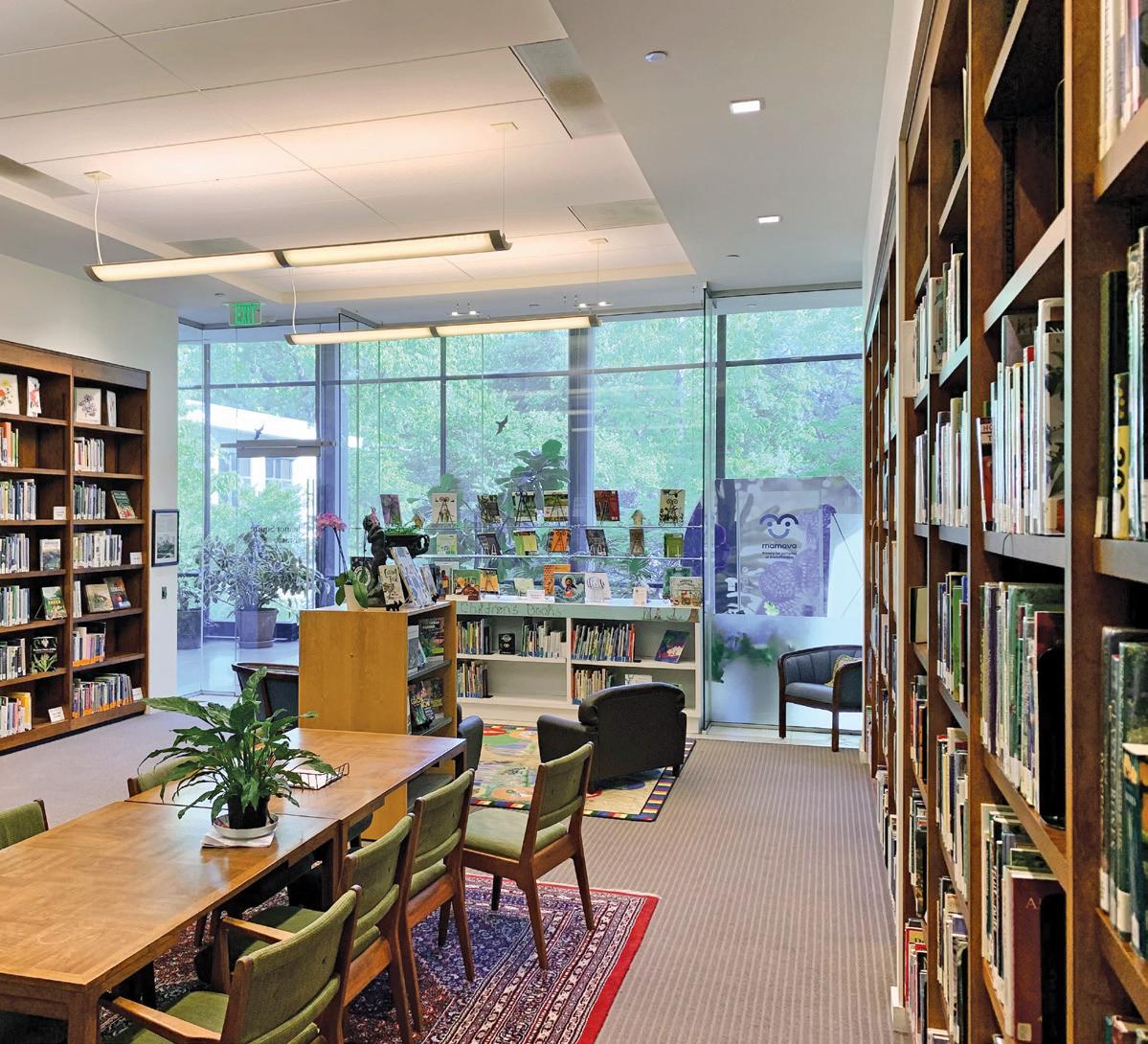
Frequently Asked Questions about HF&G Libraries
When can I visit?
At the Arboretum, you can visit whenever the Visitor’s Center is open, but for the best experience come at a time when we are staffed. Because we only have one librarian for both locations, we rely on our volunteers to keep us running, so please call ahead if you want to be sure of catching us at our best. We endeavor to have the Botanical Garden Library open, and the Arboretum Library staffed during the following hours:
• Tuesday, Thursday, Sunday 1-4 p.m.
• Saturday 10 a.m.-4 p.m.
How do I check books out?
HF&G members and volunteers can check out up to 10 books or magazines for a period of three weeks with no fines. Not going to make it back in time? Just email library@holdenfg.org or call us to renew your books. If you need to return your books while the library is not staffed, you can return them to the front desk at either location.
MEET THE STAFF
This whole plant library thing seems really neat. How can I help support it?
The best way to support the library is by visiting us and telling your friends about us! If you’d like to do more, you can volunteer to help staff the library or work on projects. We’re working hard to bring you an updated collection, but in the meantime we cannot accept most book donations.

I’d love to read and talk more about plants! Is there a way I can do that?
Yes! We have a public book club that runs regularly with a new book to read every other month. Check out the classes page on our website (holdenfg.org) to register.
BytheNumbers:
13,000 volumes
30+ volunteers
26 magazine subscriptions
300+ questions about plants and trees answered in the last year
SUMMER 2023 23 EDUCATION
Marisha Sullivan is the Librarian for Holden Forests & Gardens. She has spent her career advocating for empathetic policies that improve accessibility and inclusivity. While mostly known for her librarianship, she has also worked with NASA Glenn as a curriculum consultant and as a creative writing and theatre instructor. Her passion for nature comes from a long family line of women who believe that happiness is best found by weeding the garden and drinking tea.
Eastern Meadowlark

Sturnella magna
By Rebecca Thompson, Education Manager at Holden Arboretum

Eastern meadowlarks are found in eastern North American meadows, grasslands, prairies and small agricultural fields. They are difficult to spot on the ground since their brown-and-black upperparts are camouflaged by their grassy surroundings. However, while singing on a perch, their brightyellow underparts and the black V across their chests make them easily identifiable.
Eastern meadowlarks forage on the ground. They probe for insects by pushing their bills into the ground, then open their beaks to disturb the dirt, exposing their prey. Their primary insect diet includes grubs, caterpillars, grasshoppers and crickets. When insects are scarce, they eat seeds, berries and agricultural grains, including corn.
Eastern meadowlarks establish breeding territory in grassy areas with six or more acres. Both males and females return to the same territory every year. Male meadowlarks typically have two mates at the same time. Once pairs are established, females find a slight depression on the ground, usually camouflaged by dense vegetation, to construct the nest. In four to eight days, females build a domed cup-shaped nest six to nine inches wide and two to three inches deep. Nests are made of dry grasses and sometimes hair.
Females lay three to five white, reddish /purple-brown speckled eggs. Females only incubate the eggs for 13 to 15 days. Young are tended to by both parents but mainly females. Young leave the nest in 11 to 12 days. Males take over feeding the young while the females renest. Eastern meadowlarks typically raise two sets of young annually. They will renest if their first attempt fails.
MEET THE STAFF
BIRD FACTS
SIZE: 7.5-9.5 inches Wingspan: 14-15.5 inches
DESCRIPTION: pale brown with black, bright-yellow underparts and yellow above the eye, bold black V across the chest, and visible white outer tail feathers during flight.
RANGE: Year-round throughout much of the grasslands of the eastern United States and parts of Central and South America. Their breeding range extends from southeastern Canada, west to the Great Plains and south along the Appalachian Mountains. Northernmost individuals winter in southern areas.
VOICE CALL: High buzzy alarm note

SONG: Clear, mellow whistle, “Spring is Here.”
BEST LOCATION TO VIEW: Arboretum: Grasslands along Sperry Road, Corning Lake and Strong Acres

According to the North American Breeding Bird Survey, populations of eastern meadowlarks fell approximately 2.6% per year between 1966 and 2019, resulting in a cumulative decline of 75%. A decrease in habitat quality is considered the primary cause of population decline. Early mowing, overgrazing and pesticides can harm nesting meadowlarks. In addition, small farms with pastureland and grassy fields have been replaced by development or more extensive, row-cropping agricultural farms. Conservation efforts by private landowners are essential for the survival of the eastern meadowlark.
Rebecca Thompson is the Education Manager at Holden Forests & Gardens and has dedicated her career (1999 – present) to school-aged children and life-long learners. Her enthusiasm for the natural world has kindled a sense of exploration, discovery and a deeper appreciation for the environment. Her passion for bird watching drove her to become a self-taught local bird expert. She has served as President on local boards, including Blackbrook Audubon Society and Cleveland Regional Council of Science Teachers.
24 FORESTS & GARDENS BIRD BIO





Tall Standing
By
Conifers are among the “signature” collections at Holden Forests and Gardens. They play a role in many of our landscapes and gardens, not to mention the magnificent white pine and Canada hemlock that grace Holden’s natural areas. Of the first 101 accessions at Holden Arboretum (193134) 100 were conifers!
In our gardens, conifers provide year-long interest and sport green, yellow and blue foliage, along with chartreuse, red and purple new cones. Their differing shapes and growth rates allow us to grow the largest trees in the world, the oldest and some of the most diminutive. Conifers have been mixed into many of the gardens at Cleveland Botanical Garden and Holden Arboretum, where they provide structure, contrast and companion plantings for flowering plants.
Presently at Holden the conifer collection contains five families, 24 genera, 122 species, 299 cultivars and 1,888 plants and plant groupings. Sixty-nine of the species are represented by wild collected specimens, with two of those being cultivars that originated in the wild. Of those wild collected species, 12 are listed as being of conservation concern by the International Union for the Conservation of Nature. We will continue to increase the number of wild collected conifers to make our collection more useful for conservation and scientific study.
While many of the conifers planted at the arboretum in the early years were from the western U.S., a good number of them were of eastern North American, European and Asian origin. The western U.S. conifers have had the highest mortality rates. Needle cast has infected the western spruces with Colorado blue spruce being a noticeable casualty. Winter weather killed our giant sequoia (Sequoiadendron giganteum) at the arboretum in past decades. In 2017, a small ‘Powder Blue’ giant sequoia was

26 FORESTS & GARDENS
The conifers are among the first plants to be added at Holden Forests & Gardens.
Ethan Johnson, Plant Records Curator
Blue noble fir
planted at Cleveland Botanical Garden (CBG) on the south side of the Woodland Garden and is seven feet tall.
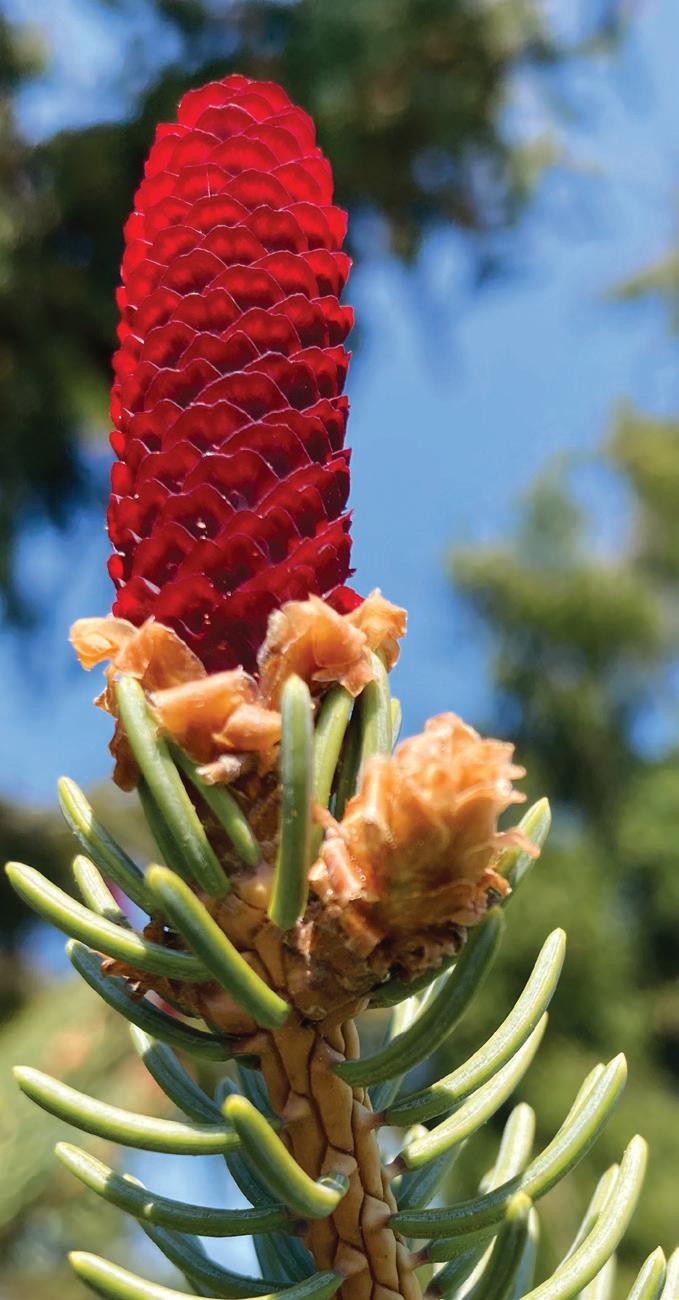


The tallest conifers at Holden are white pines (Pinus strobus) measuring 110’ on “Michigan Hill” north of the Emergent Tower. These were planted in 1939 by Ben Bole Jr. and Warren Corning. In 1942, bristlecone pines were planted on Spruce Knoll but never produced cones and the last one died in January 2021. Bristlecone pines being from high elevations only photosynthesize at temperatures less than about 70 degrees F so are “starved” during our summers. They, like other subalpine species, generally require better soil drainage than our somewhat poorly drained silt loam at the arboretum affords them. I remember Bill Hendricks of Klyn Nurseries in the spring of 2015 showing me winter-killed conifers on the flats, but the same conifers alive on slopes that naturally drained. Our climate has only gotten wetter in recent decades.

MEET THE STAFF
While we are not about to give up on growing certain western North American conifers at Holden, our emphasis with acquisitions has changed due to conditions beyond our control. We have been acquiring confers native to the Great Lakes Region and other parts of central and eastern North America in larger numbers than their western counterparts. To include more examples in our garden areas, dwarf conifers have been added. These slow-growing trees or shrubs originate as branch mutations called witch’s brooms, which may be grafted or even selected from seed from a broom if cones are found. A number of these dwarf conifers are of documented wild origin and were collected in places such as the Upper Peninsula of Michigan by American Conifer Society friends.
During recent decades at the arboretum, outer collections have been deemphasized, but the conifers planted from KirtlandChardon Road to Hourglass Pond have been actively curated and maintained. There will be endangered or threatened trees (conifers and others) planted in outer areas in groves that are to serve as sanctuaries and as destinations.
Ethan Johnson is the Plant Records Curator. He learned to keep records while working for the Arnold Arboretum (1985-89) and Holden Arboretum (1981-82, 1989-present) while volunteering for the International Dendrological Research Institute, Ohio Nursery and Landscape Association Plant Selection Committee and the American Conifer Society. He was the point person when the American Association of Museums accredited Holden Arboretum as the sixth public garden in the U.S. as a museum, has labeled and inventoried Holden Arboretum’s plant collection and has been keeping plant records at Cleveland Botanical Garden since 2015.

SUMMER 2023 27 PLANT PROFILE
Young cone of dragon spruce
Young cones of Alcock spruce
Young cones of Korean fir
Young cones of Khingan fir
Classes&Programs
JAPANESE PRUNING 101

July 7
FIRST FRIDAY GARDEN TOUR: RHODODENDRON DISCOVERY
Holden Arboretum | 9 – 11:30 a.m.
$5 per member, $20 per nonmember
Families
July 9
THE BASICS OF BASKETRY
Holden Arboretum | 10 a.m. – 2 p.m.
$40 per member, $55 per nonmember
Adult
MAGNIFICENCE ON THE MOUNTAIN HIKE
July 15
Holden Arboretum | 11:30 a.m. – 3 p.m.
$10 per member, $20 per nonmember
Adult, children 12 years & over with adult
July 19
Cleveland Botanical Garden | 6 – 8 p.m.
$30 per member, $45 per nonmember
Adult
July 21
WINE & CHEESE NIGHT HIKE
Holden Arboretum | 8 – 11 p.m.
$30 per member, $45 per nonmember
Adult, 21+
July 22
BOTANICAL NATURE JOURNALING
Cleveland Botanical Garden | 10 a.m. – Noon
$60 per member, $75 per nonmember
Adult, teens 15 years & over
July 29
TOPIARY FROM START TO FINISH WITH MIKE GIBSON
Cleveland Botanical Garden | 10 a.m. – Noon
$25 per member, $30 per nonmember
Adult
28
FORESTS & GARDENS
August 3
BREW YOUR OWN BEVERAGE: KOMBUCHA
Cleveland Botanical Garden | 6 – 8 p.m.
$35 per member, $50 per nonmember
Adult
FIRST FRIDAY GARDEN TOUR: ARLENE AND ARTHUR S. HOLDEN JR BUTTERFLY GARDEN
August 4
Holden Arboretum | 9 – 11:30 a.m.
$5 per member, $20 per nonmember
Families
BOTANICAL CYANOTYPE ART
August 5
Holden Arboretum | 1 – 3 p.m.
$40 per member, $55 per nonmember
Adult
FAMILY OVERNIGHT CAMP OUT AT THE ARBORETUM
August 25
WINE & CHEESE NIGHT HIKE
Holden Arboretum | 8 – 11 p.m.
$30 per member, $45 per nonmember
Adult, 21+
HEALING THE FIRES: PLANT ALLIES FOR INFLAMMATION
August 26
Holden Arboretum | 9 a.m. – Noon
$35 per member, $50 per nonmember
Adult
Sept 1
FIRST FRIDAY GARDEN TOUR: CORNING LAKE
Holden Arboretum | 9 – 11:30 a.m.
$5 per member, $20 per nonmember
Families
August 5
Holden Arboretum
$25 per member, $30 per nonmember
Families (children ages 4 and above)
STEBBINS GULCH: A HIKE
THROUGH GEOLOGICAL HISTORY
Sept 9
COMMUNITY SUPPORTED AGRICULTURE WITH CITY FRESH
Cleveland Botanical Garden | 10:30 – 11:30 a.m.
$5 per member, $20 per nonmember
Adult
August 19
Holden Arboretum | 11:30 a.m. – 3:30 p.m.
$10 per member, $20 per nonmember
Adult, children 12 & over with adult
FUN WITH FLORAL ARRANGING
August 24
Cleveland Botanical Garden | 6 – 7:30 p.m.
$45 per member, $60 per nonmember
Adult
Sept 16
STEBBINS GULCH FAMILY HIKE
Holden Arboretum | 1 – 4 p.m.
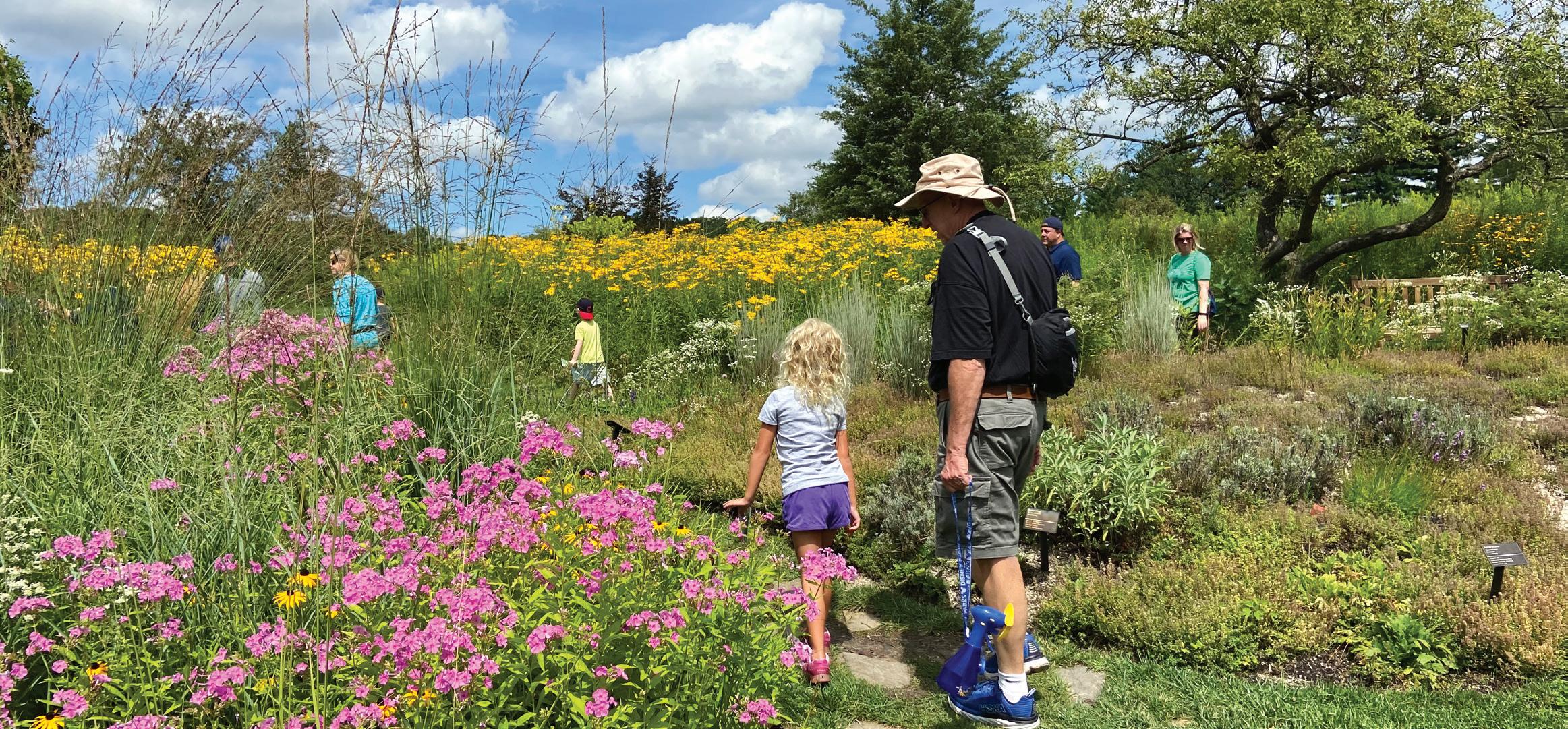
$10 per member, $20 per nonmember
Children 9 & over with adult
Sept 23
GARDENING TO SAVE THE WORLD
Cleveland Botanical Garden | 10 a.m. – Noon
$25 per member, $40 per nonmember
Adult
SUMMER 2023 29 CLASSES & PROGRAMS
Summer Fun
Mark your calendar for these events.
CLEVELAND BOTANICAL GARDEN
HERSHEY CHILDREN’S GARDEN - FIREFLIES
July 6, Regular hours
LISTEN CLE- AMINAH LOUISE
July 13, 6-8 p.m.
GOURMETS - ZANZIBAR
July 20, 6-7 p.m.
$10 member/$24 nonmember
LISTEN CLE - JANESSA CARDILLO
July 27, 6-8 p.m.
HERSHEY CHILDREN’S GARDENNIGHT BLOOMERS
August 3, Regular Hours
LISTEN CLE - MARK BURNETT
August 10, 6-8 p.m.
GOURMETS- BLACK BOX FIX, CHEF ERIC ROGERS
August 17, 6-7 p.m.
$10 member/$24 nonmember
LISTEN CLE- THE BEWILDERNESS
August 24, 6-8 p.m.
GOURMETS- MARIGOLD CATERING
August 31, 6-7 p.m.
$10 member/$24 nonmember
* Find more information about events on holdenfg.org.
HOLDEN ARBORETUM
TAILS & TRAILS
July 5, 5-8 p.m.
CONCERT - CLE WIND TRIO
July 12, concessions 5:30 p.m./concerts 6-7:30 p.m.
BUCKEYE BUDS CHILDRENS AREA
July 19, Open during regular hours
CONCERT IN PARTNERSHIP WITH ROOTS OF AMERICAN MUSIC- SAM HOPPER


July 26, concessions 5:30 p.m./concerts 6-7:30 p.m.
TAILS & TRAILS
August 2 , 5-8 p.m.
MEMBER NIGHT & CONCERT IN PARTNERSHIP WITH ROOTS OF AMERICAN MUSIC-MO' MOJO (ZYDECO)
August 9, concessions 5:30 p.m./concerts 6-7:30 p.m.
BUCKEYE BUDS CHILDRENS AREA
August 16, Open during regular hours
WINE TASTING
August 23, 6-8 p.m.
$65 member/$75 nonmember
CONCERT IN PARTNERSHIP WITH ROOTS OF AMERICAN MUSIC-GRUVE TONIC (SOUL/R&B/ POP/ROCK)
August 30, concessions 5:30 p.m./concerts 6-7:30 p.m.
30
FORESTS & GARDENS

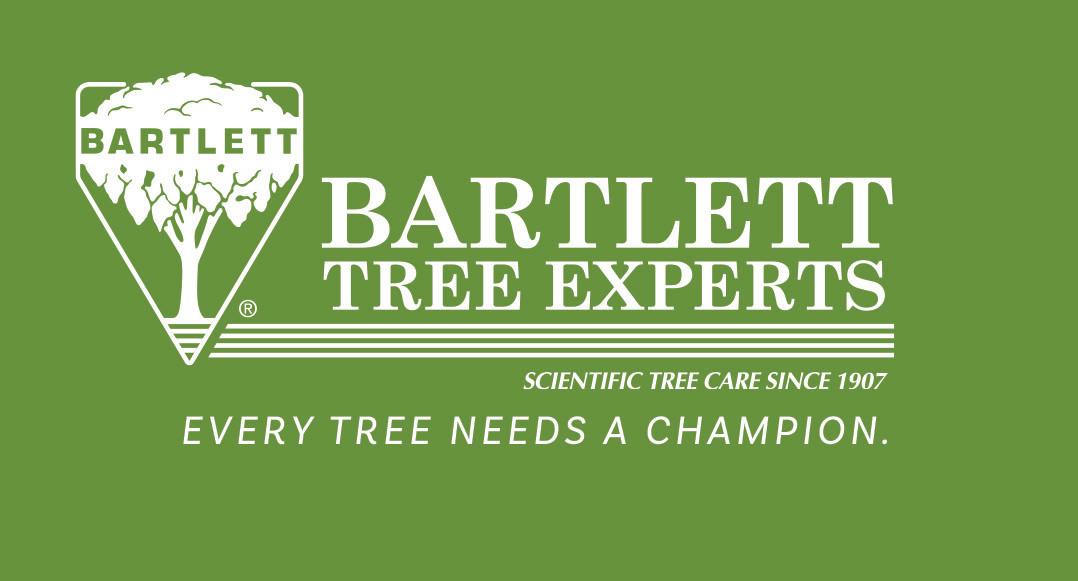
9500 Sperry Road
Kirtland, Ohio 44094
holdenfg.org
Make an Impact
Calling all Green Thumbs!
Volunteer at Holden Forests & Gardens!

Are you passionate about plants, nature, and our environment? We are seeking enthusiastic volunteers to join us in our gardens and help us create a vibrant and sustainable space for guests to enjoy! No green thumb? No problem! Whether you’re a seasoned gardener or a complete novice, we welcome volunteers of all skill levels. Our team is dedicated to providing guidance and support to help you develop your gardening skills. Visit holdenfg.org for more information.
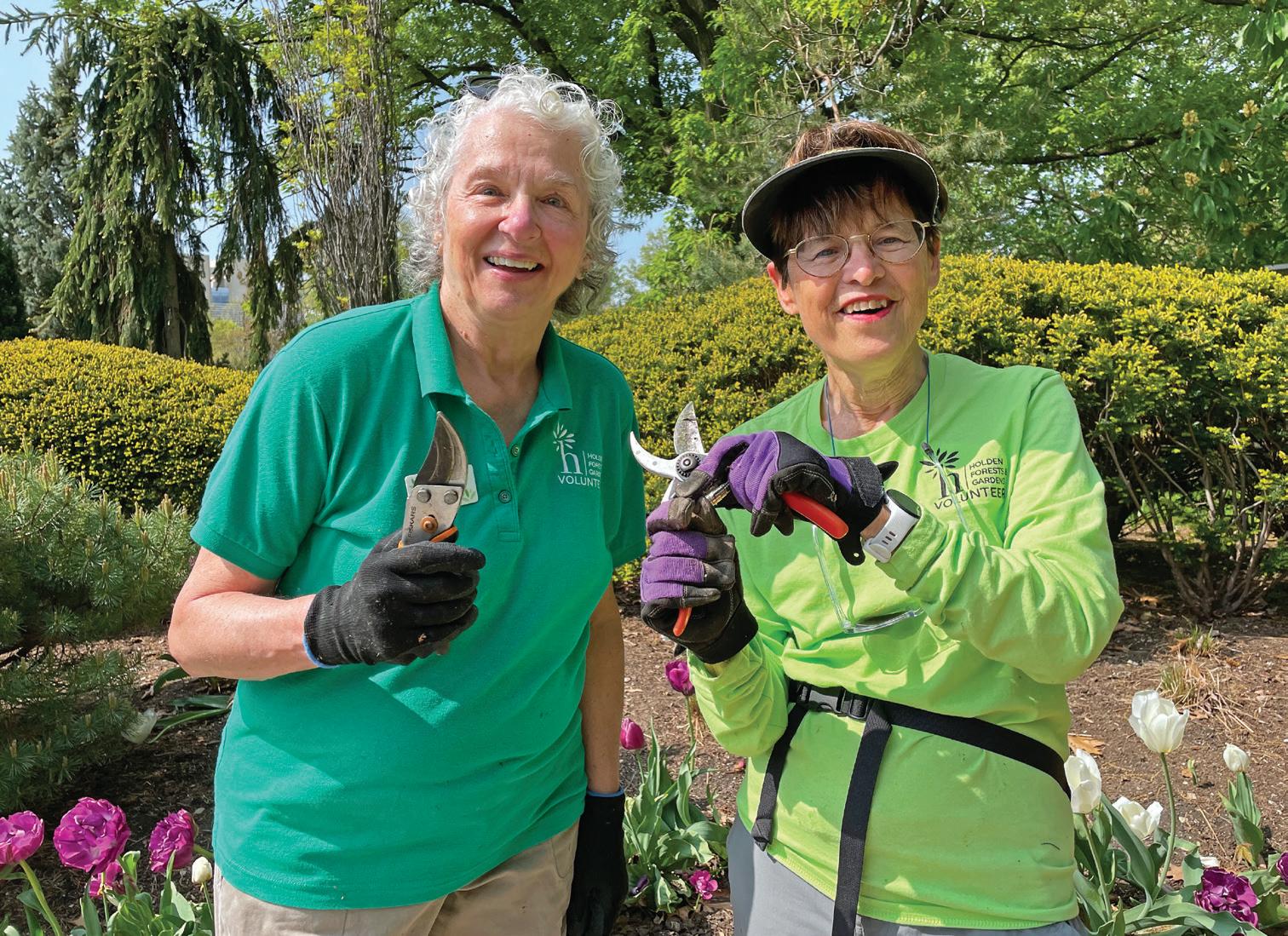
Forests & Gardens is the member magazine for Holden Forests & Gardens, which includes the Holden Arboretum in Kirtland and the Cleveland Botanical Garden in Cleveland.
MISSION: Holden Forests & Gardens connects people with the wonder, beauty, and value of trees and plants, to inspire action for healthy communities

VISION: All communities transformed into vibrant places where trees, plants, and people thrive ©Holden Forests & Gardens
“Holden Forests & Gardens” and the related logo is a trademark owned by The Holden Arboretum.

9550 SPERRY ROAD, KIRTLAND, OHIO 44094
HOLDENFG.ORG
440.946.4400
HOURS
TUESDAY - SUNDAY: 9AM - 5PM
JUNE - AUGUST WEDNESDAYS: 9AM - 8PM
MONDAY: CLOSED
For updates, visit holdenfg.org
11030 EAST BLVD, CLEVELAND, OHIO 44106 HOLDENFG.ORG
216.721.1600
HOURS
TUESDAY- SATURDAY: 10AM - 5PM
JUNE - AUGUST THURSDAYS: 10AM - 8:30PM
SUNDAY: NOON - 5PM
MONDAY: CLOSED
For updates, visit holdenfg.org
 @cbgarden @holdenarb @cbgarden @holdenarboretum @clegarden @holden_arb
Newsletter holdenfg.org
@cbgarden @holdenarb @cbgarden @holdenarboretum @clegarden @holden_arb
Newsletter holdenfg.org






























 By Kristen Hampshire
By Kristen Hampshire







 By Matt Edwards
By Matt Edwards













































 @cbgarden @holdenarb @cbgarden @holdenarboretum @clegarden @holden_arb
Newsletter holdenfg.org
@cbgarden @holdenarb @cbgarden @holdenarboretum @clegarden @holden_arb
Newsletter holdenfg.org